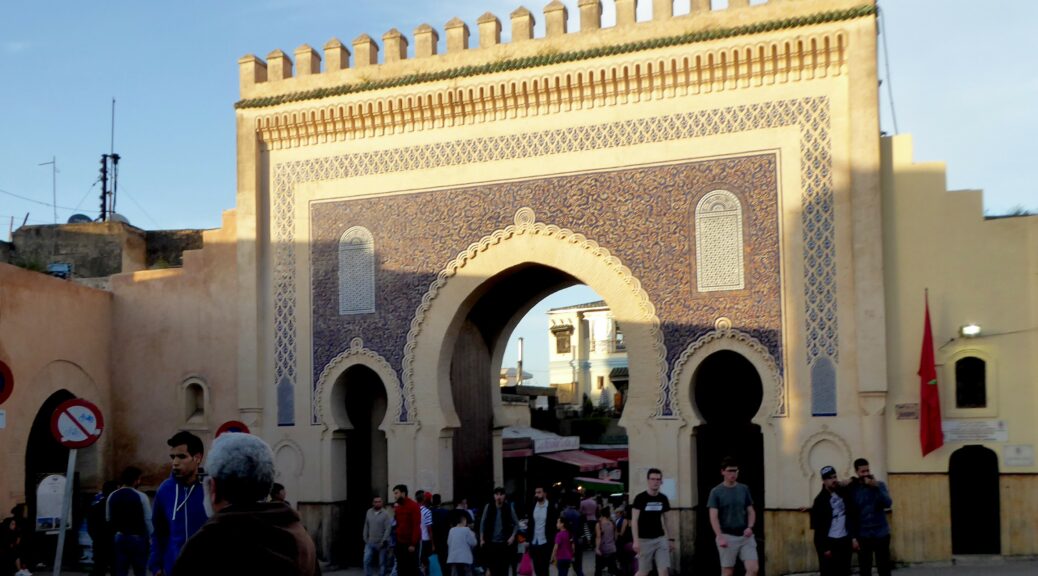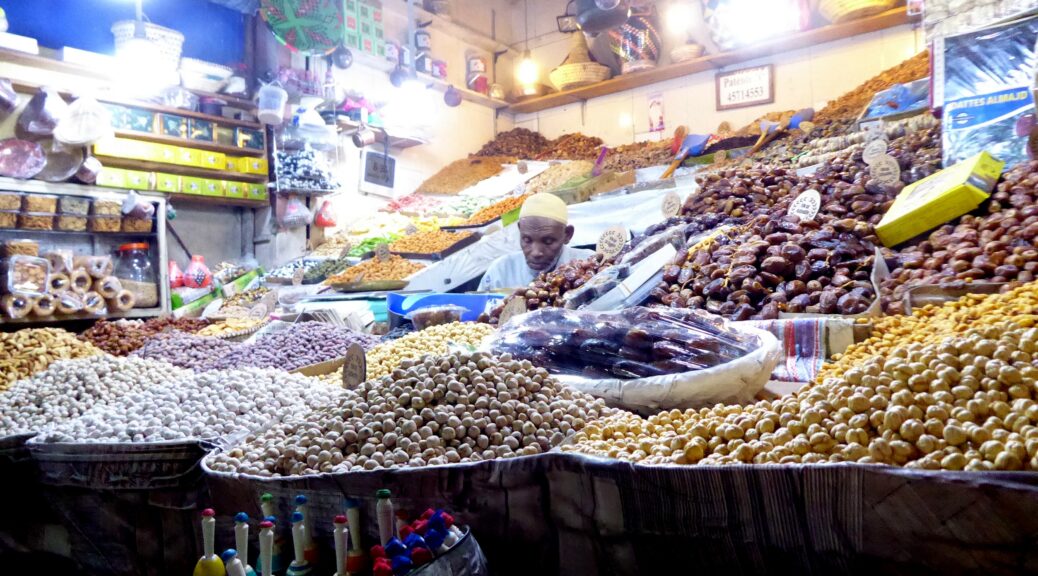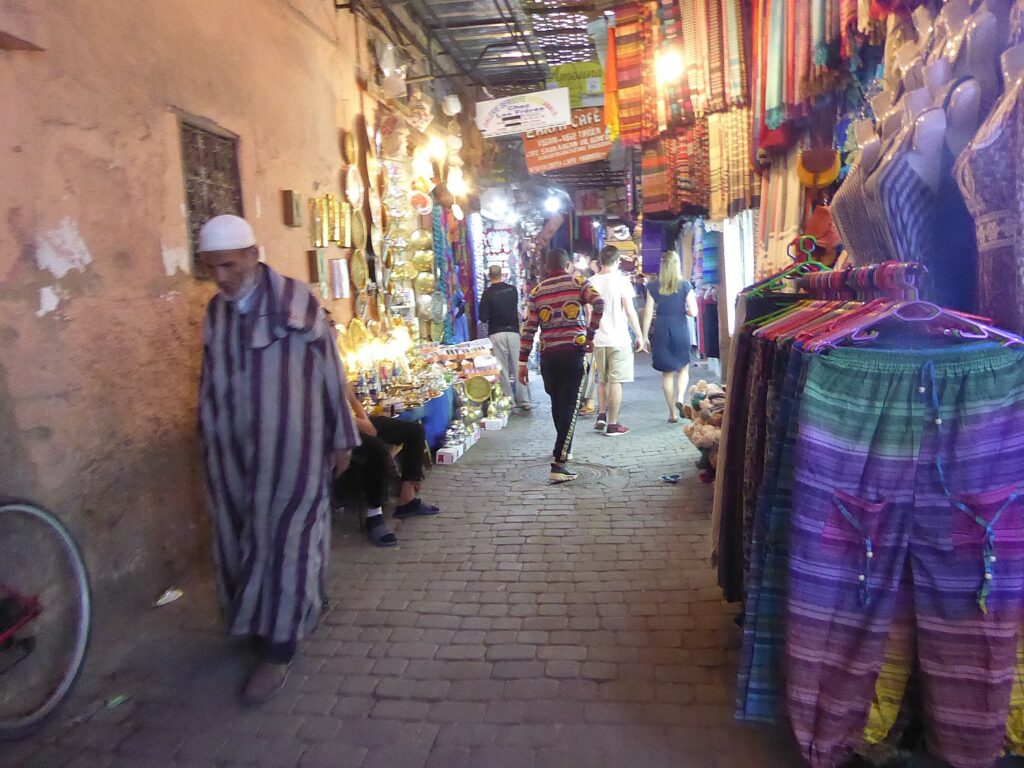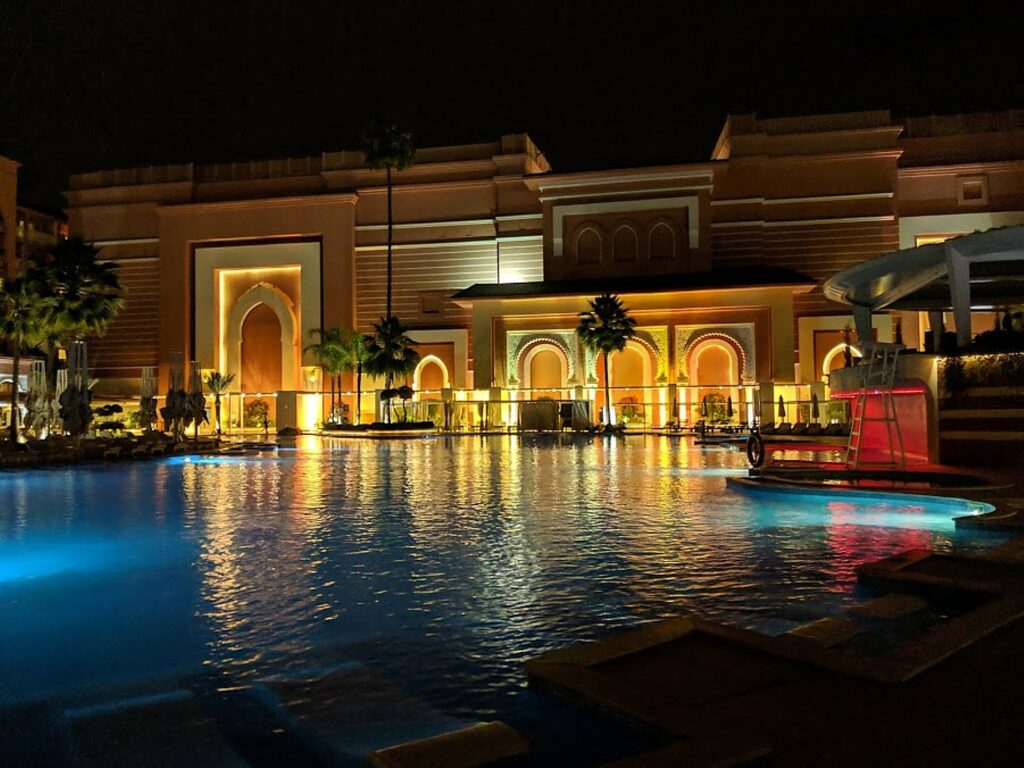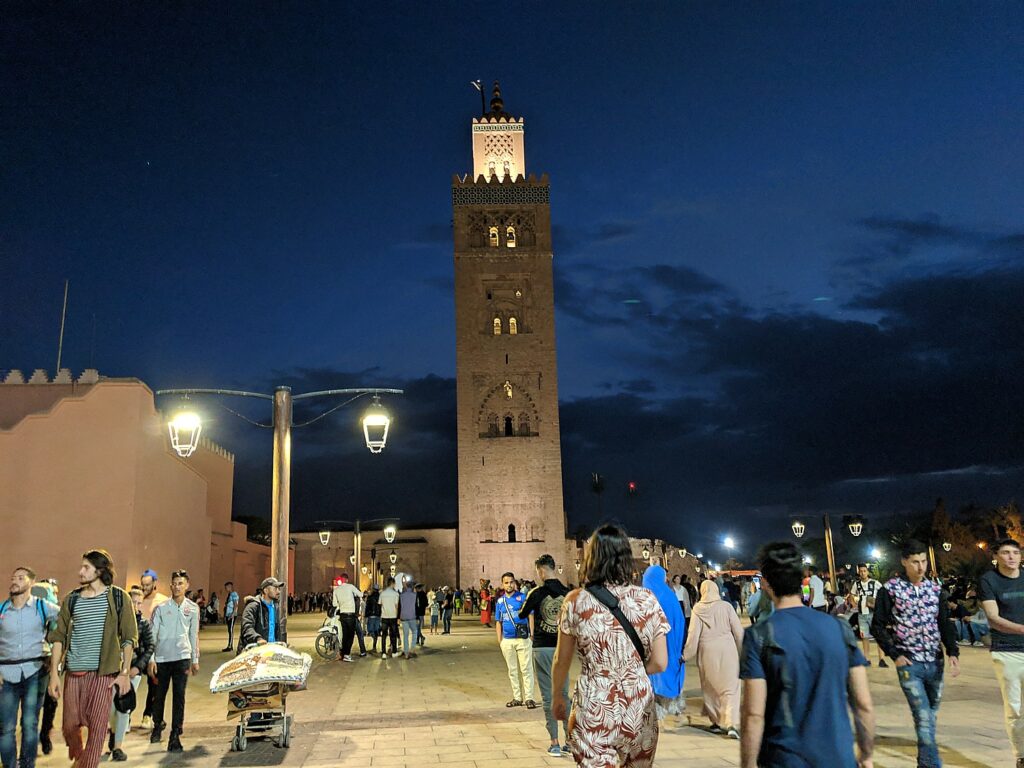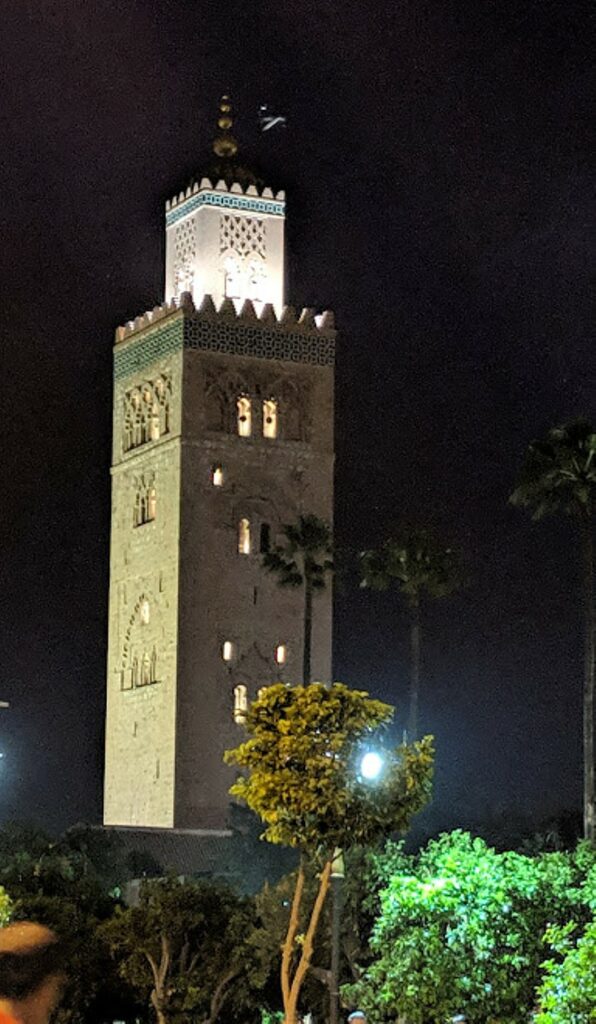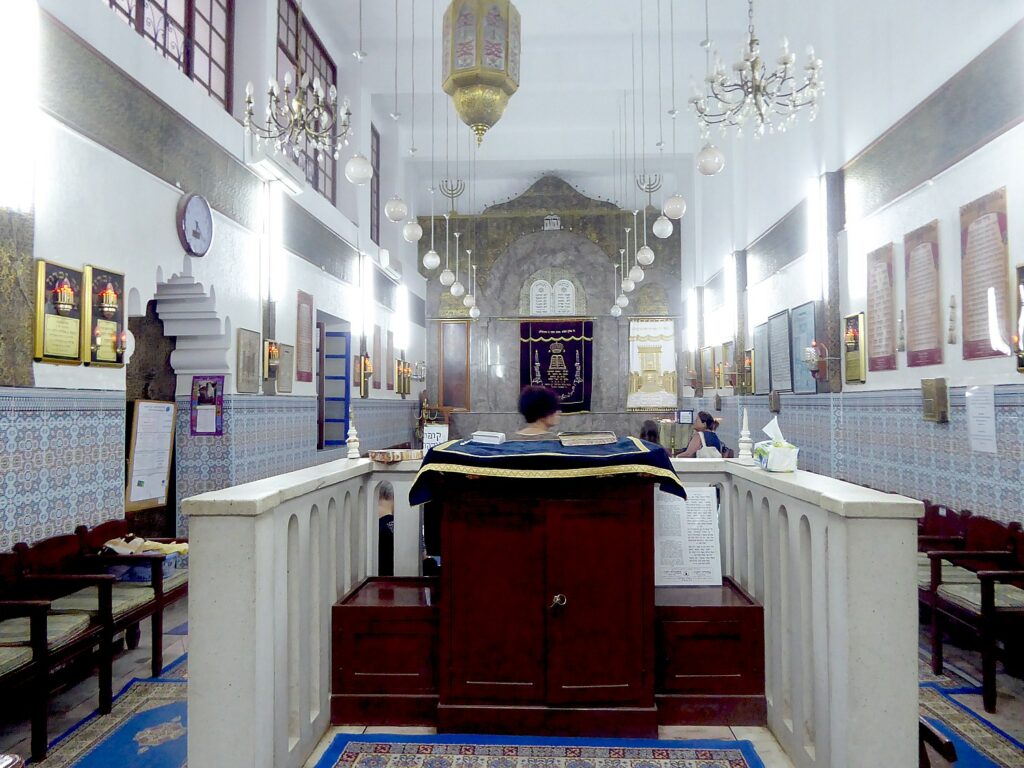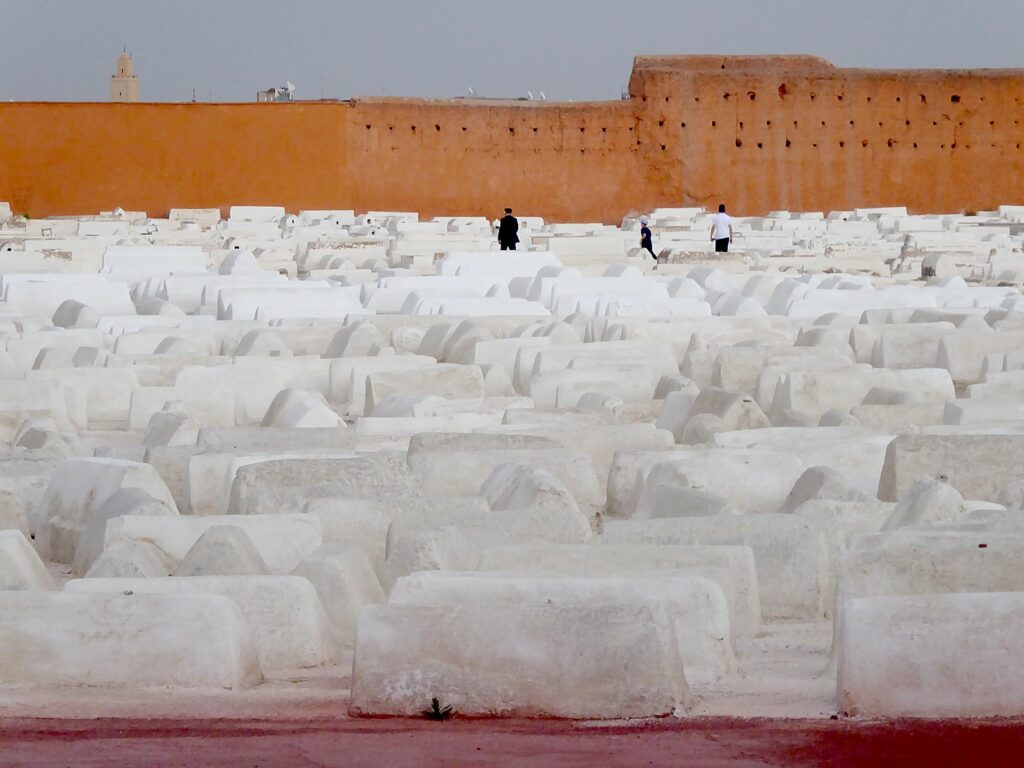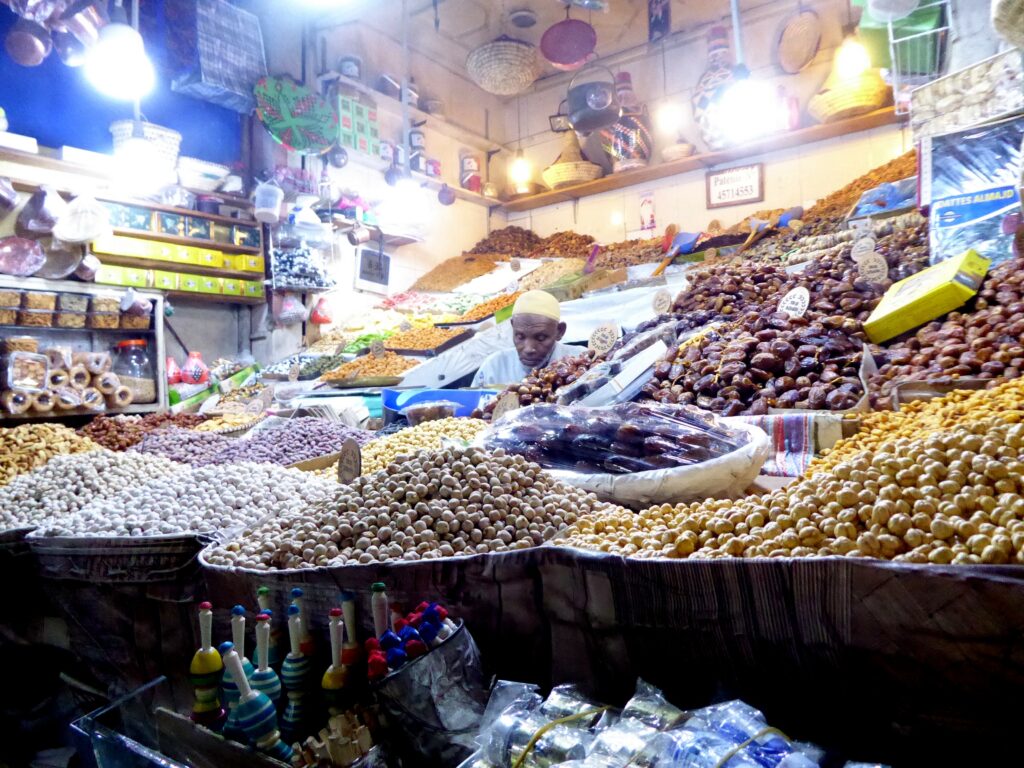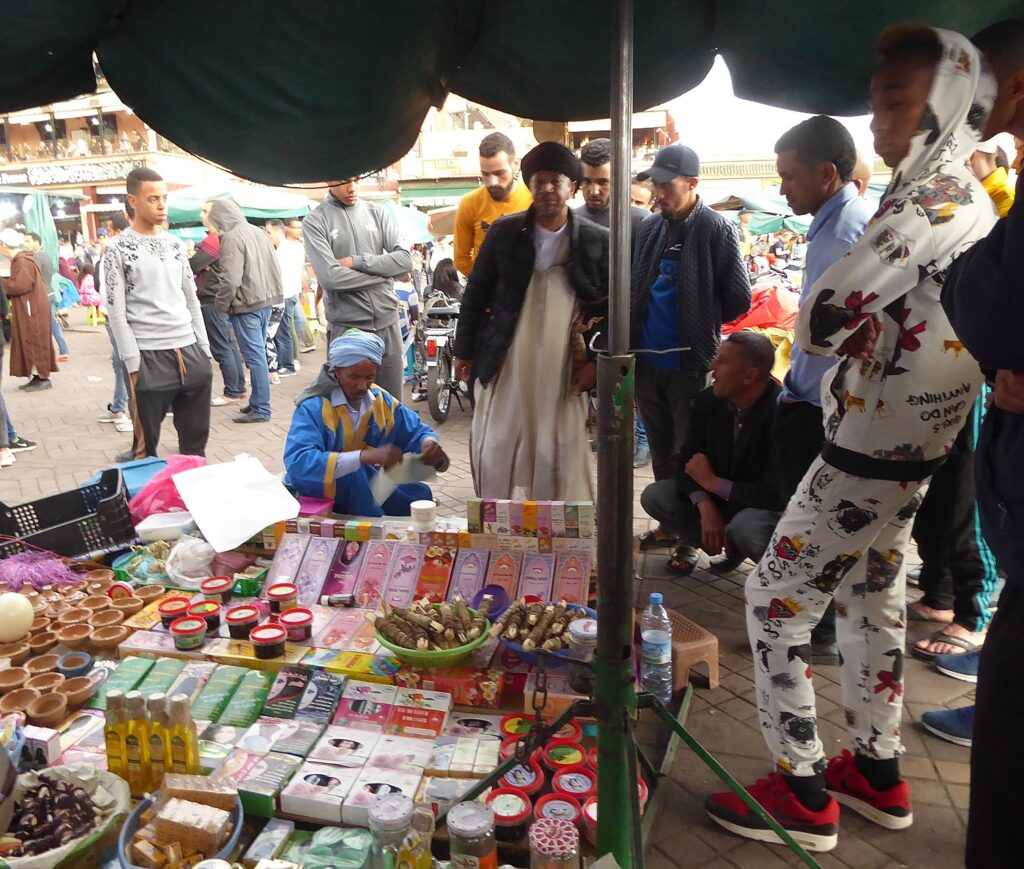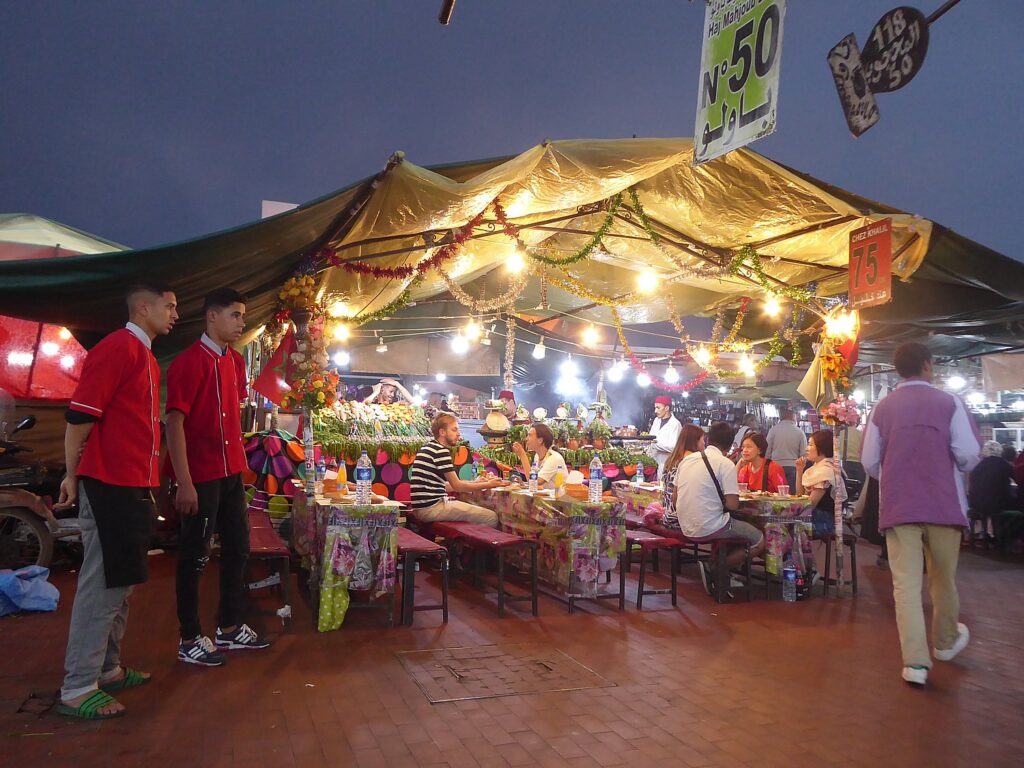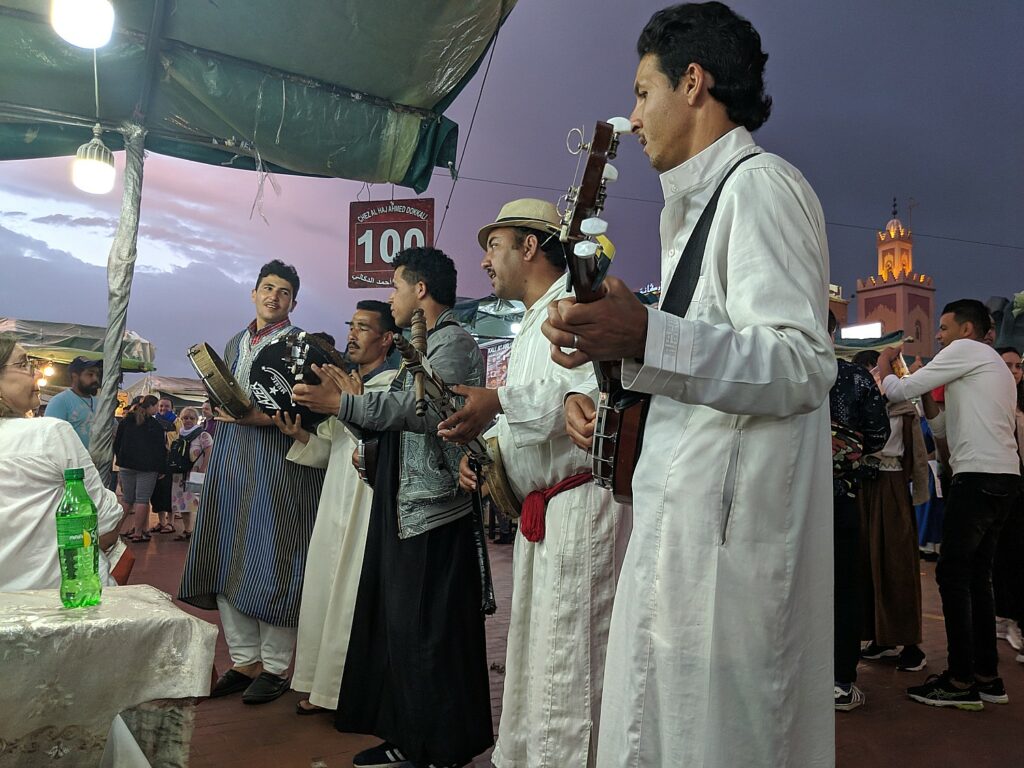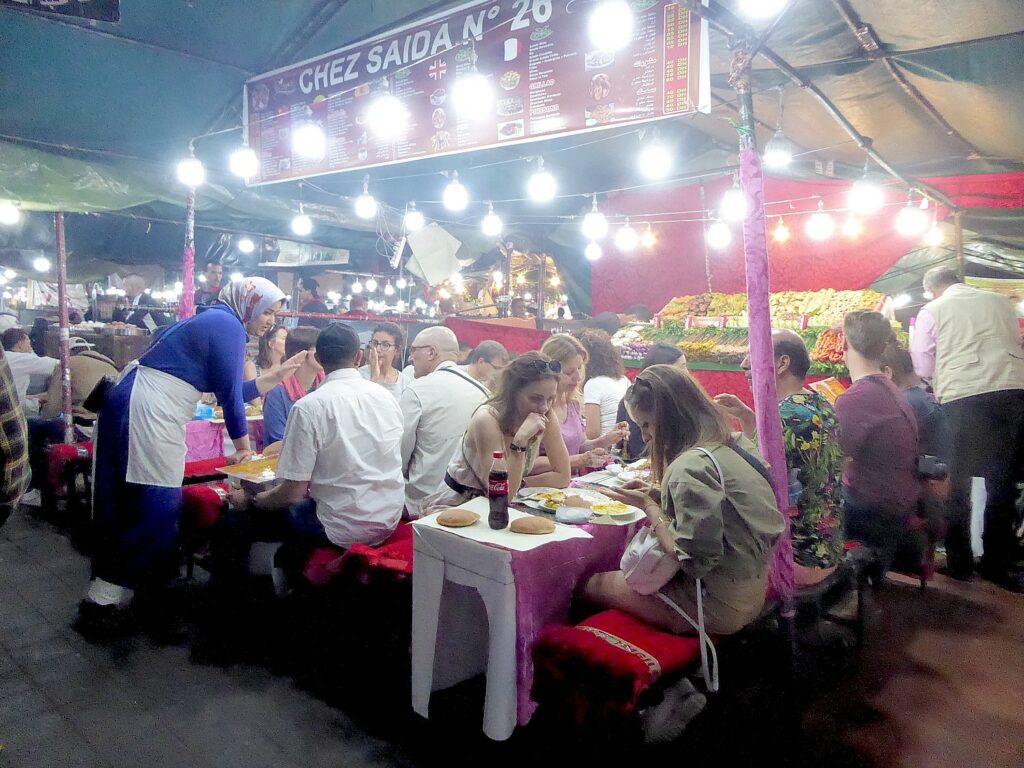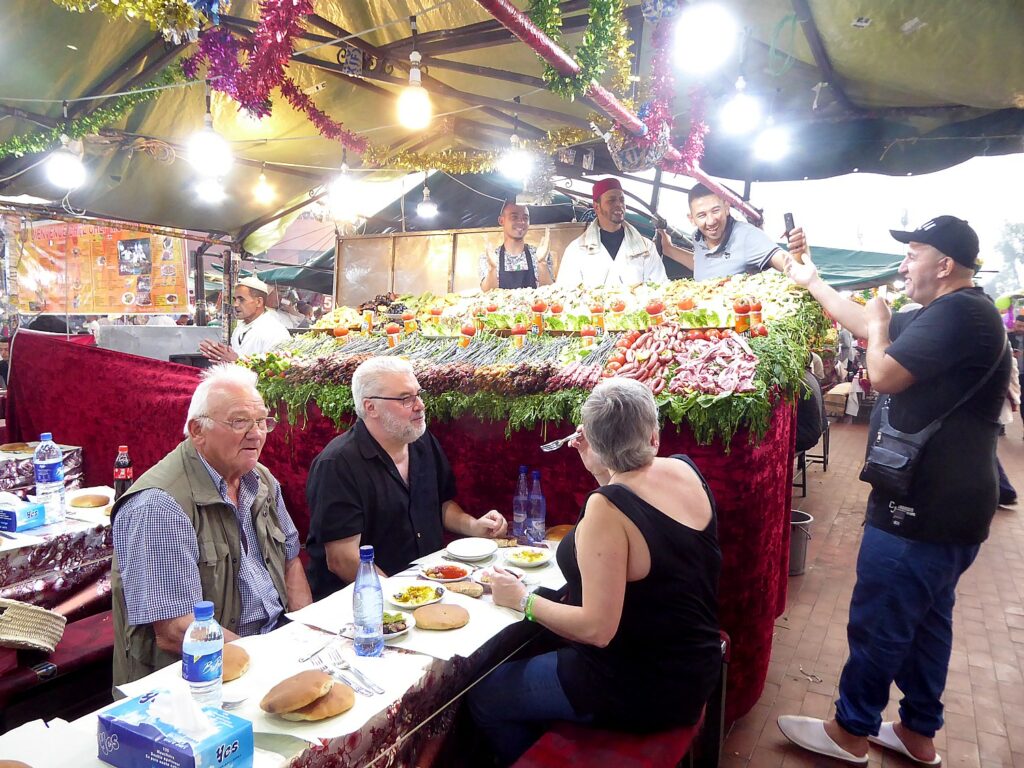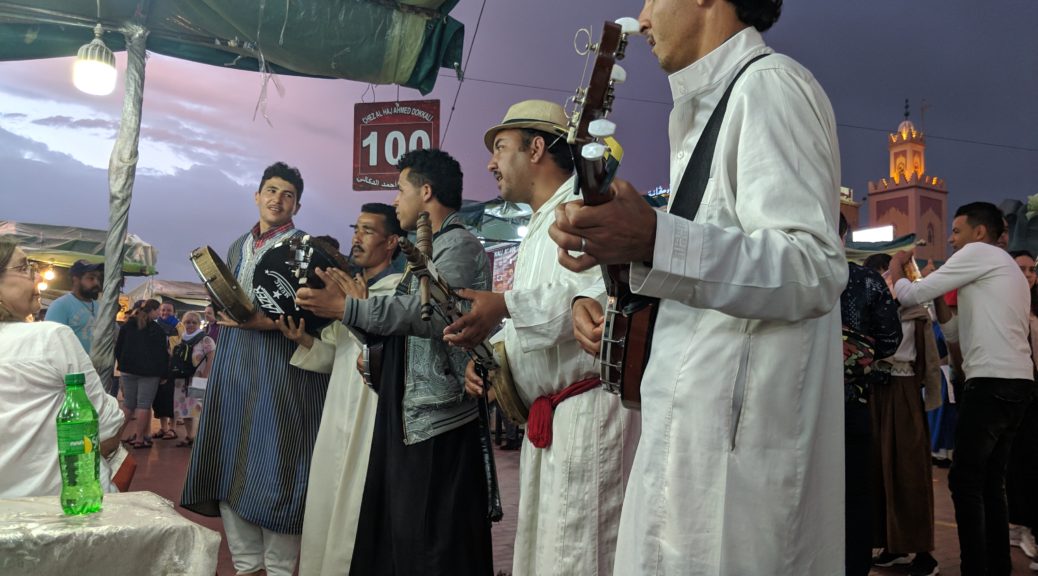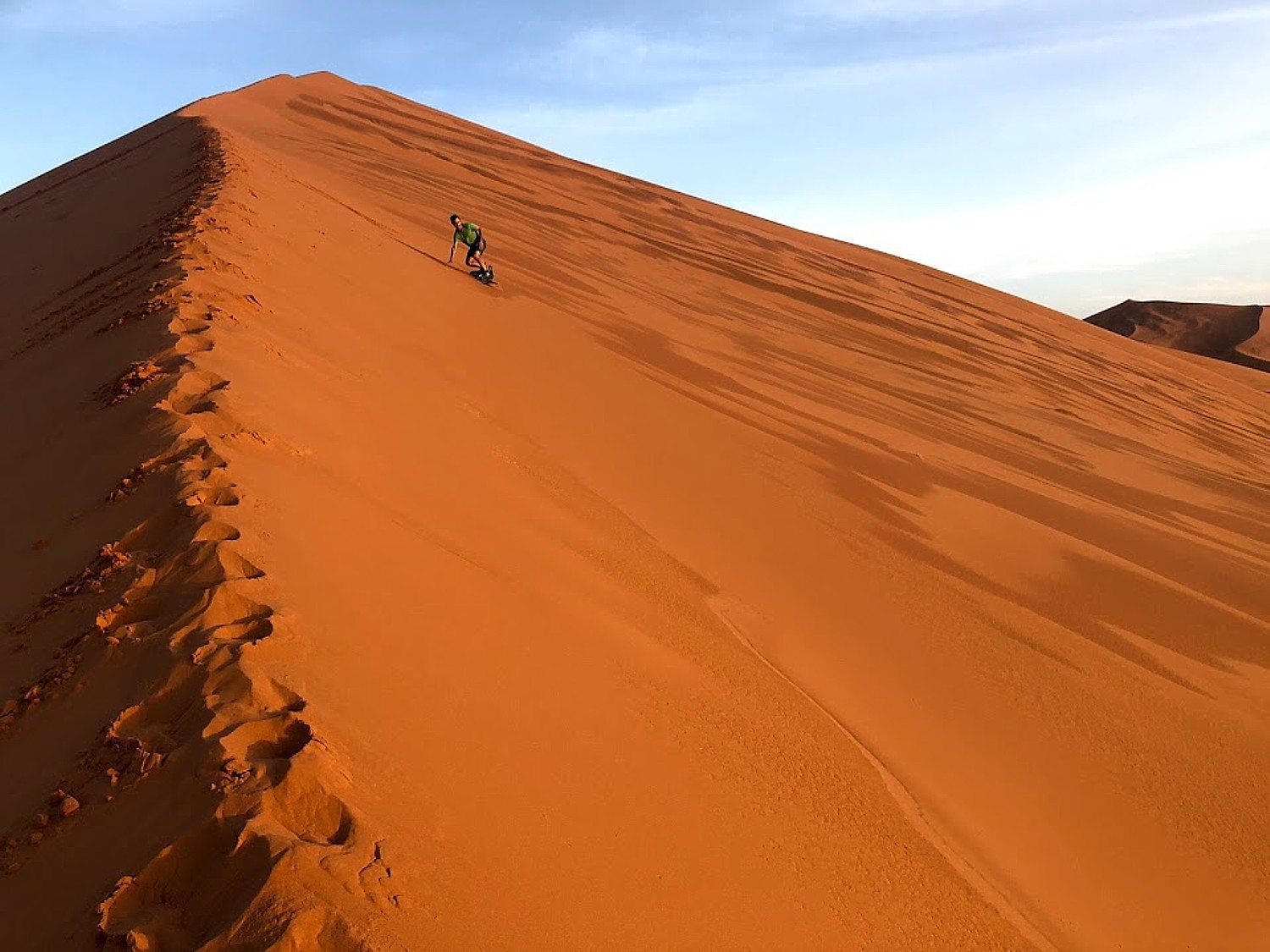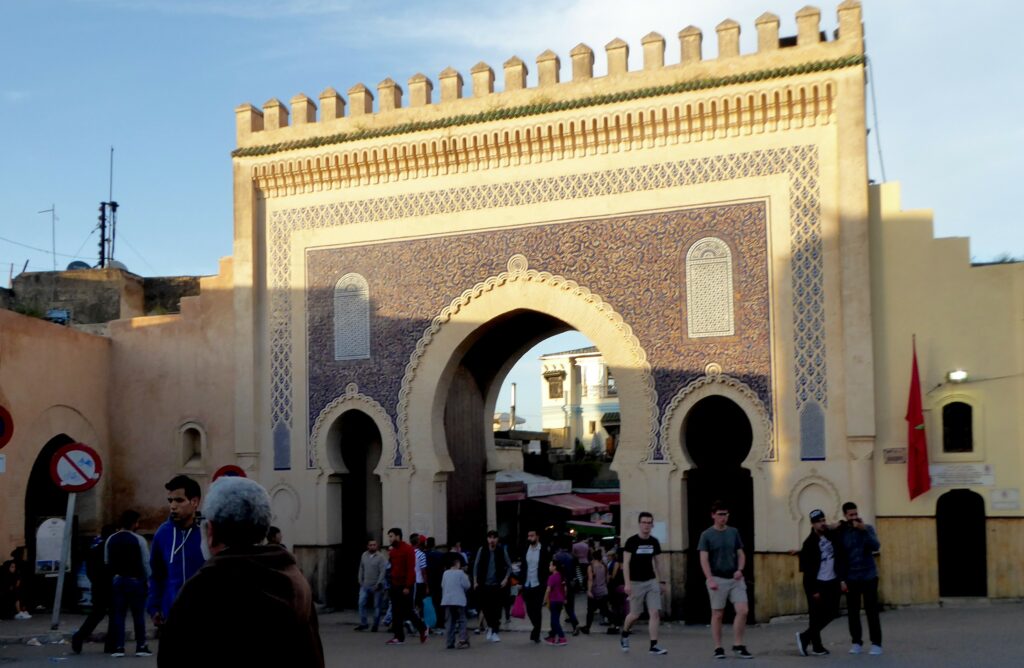
by Karen Rubin, Travel Features Syndicate, goingplacesfarandnear.com
The sun has yet to rise as we settle ourselves in the first-class compartment of the train from Marrakesh to Fez on our mad-dash on the Global Scavenger Hunt that will bring us through Morocco to Gibraltar, Spain and Portugal for the most difficult leg of the 23-day around-the-world mystery tour. The train pulls out of the modern train station exactly on time. The 6 ½-hour journey flies by as we roll through Morocco’s countryside and villages – farms and rolling hills on both sides.
The compartment seats six people very comfortably. During the course of the trip, people come and go and we engage in very pleasant conversations. A stop or two away from Fez, two fellows come in to the compartment the conversation that ends with the one fellow saying he knows a guide for us to hire to take us through the Medina – the massive gated city of thousands of alleyways which we have been strongly advised to explore with a guide. Sure enough, by the time we get off the train, the guide has arrived. And there is a taxi as well.
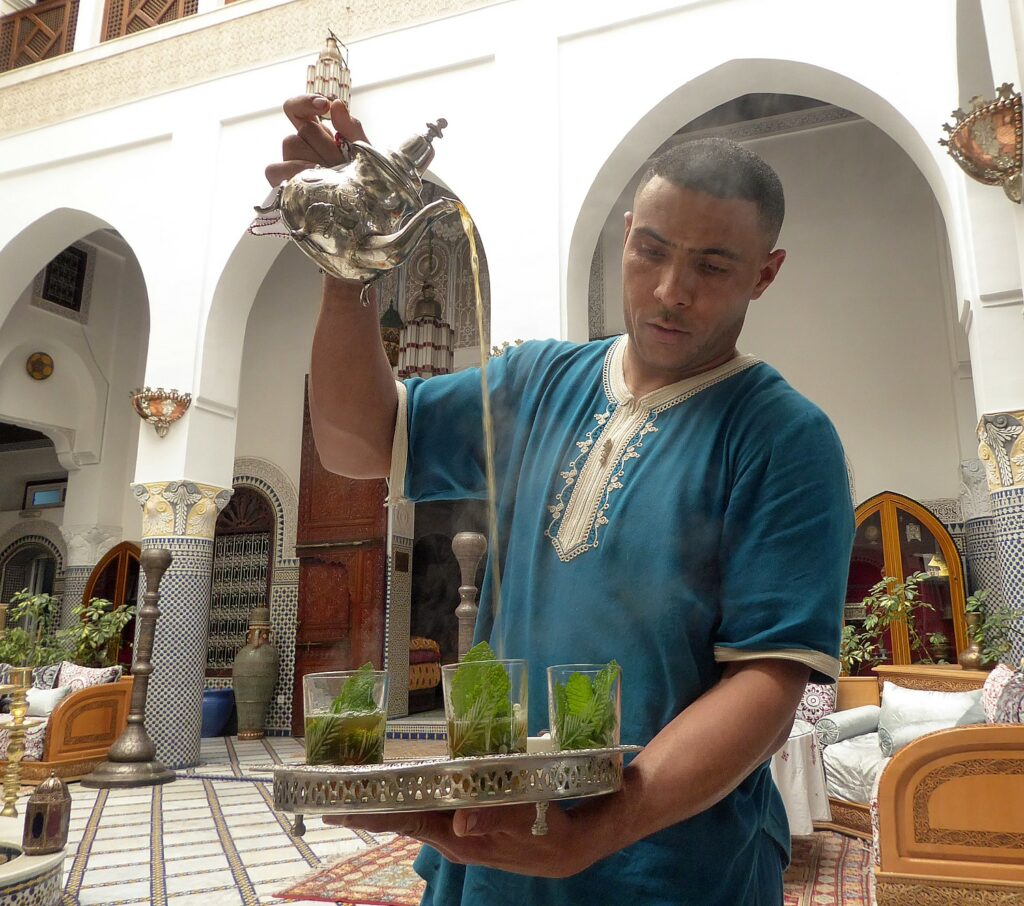
We make our way to the Riad el Yacout, a guesthouse, where we are greeted by Hadisha, a young woman who is the daughter of the owner, recently returned after spending eight years studying in Madrid, China and the United States. I can easily imagine her running a huge hotel chain at some point.
The riad (which is a traditional two-story house where the rooms are built around a courtyard) is absolutely enchanting. The riad was once the home of Professor Laharchi who taught philosophy at the famous Al Qaraouvine university. Built in 1347, the house passed generation to generation until 2000 when her father bought it.
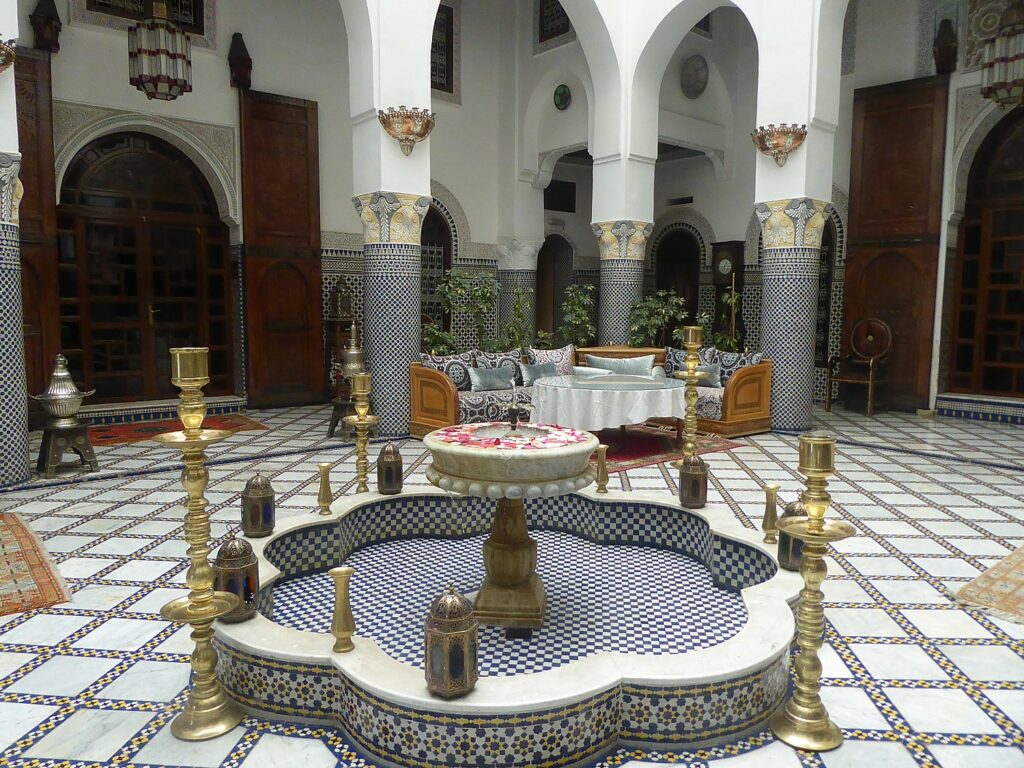
He spent five years restoring it as a 33-room guesthouse (it is actually three houses that have been linked, with a pool; and there are plans to build a third floor and add a rooftop pool). The mosaics, decoration, furnishings are exquisite – all the rooms set around the most magnificent interior courtyard. The design, facing inward, is meant to maximize family interactions. The riad has already attracted important people – two years after opening, in 2007, Bono stayed for six weeks; Queen Noor of Jordan also stayed here (Riad El Yacout, 9 Derb Guebbas, Batha, Medina, Fez).
Hadisha strongly advises us against using the guy from the train and instead hiring an approved guide and driver from the tourism office. We only have the afternoon and evening here to see Fez, and even Bill Chalmers, our Global Scavenger Hunt leader, has told us to hire a guide to go through the Medina – the largest, with some 11,000 alleyways with no addresses.
The price seems fair and we only have the afternoon, and it proves a great way to see Fez in such a brief time.
It is interesting that two other GSH teams who are also staying at the Riad and come after us (they went on a balloon ride in Marrakesh, one of the scavenges before catching the train to Fez), happened to meet and hire the same guide we were introduced to by the guy on the train (turns out the second guy on the train was his son, who I spot while walking in the Medina – what are the chances? Actually it is less coincide and more a scam – the fellows get on the train a stop or two before Fez, find a seat in the first-class compartment and begin the grift. If you are keeping count, altogether four of our Global Scavenger Hunt teams all had either met the guide (us), or used the guide or the son. And everybody was satisfied.
Even though we realize that only four teams out of the original 10 have a chance of winning the Global Scavenger Hunt and the title, “Worlds Best Travelers,” we still pursue the challenges, albeit at a more relaxed, less frenzied pace, because they basically bring us to the places we would or should visit, places or experiences we never would have thought of, and give us a much more immersive, interesting and connected experience.
Fez el-Jdid, the Jewish Quarter
My teammate, Margo, and I set out with our guide, Hamid, the fellow sent from the tourist office (having told the fellow from the train we made other plans). At our first stop, at the golden doors to the palace (and this is before he makes the connection between “New York,” and likely Jewish person)– he relates how Jews made refugees when expelled from Spain and Portugal in 1492 were invited by the sultan to settle in Fez in order to develop the city, and settle the nomadic Berbers. The sultan gave them land adjacent to the palace and promised protection. To show appreciation, the Jewish community created ornate brass doors for the palace with the Star of David surrounded by the Islamic star.
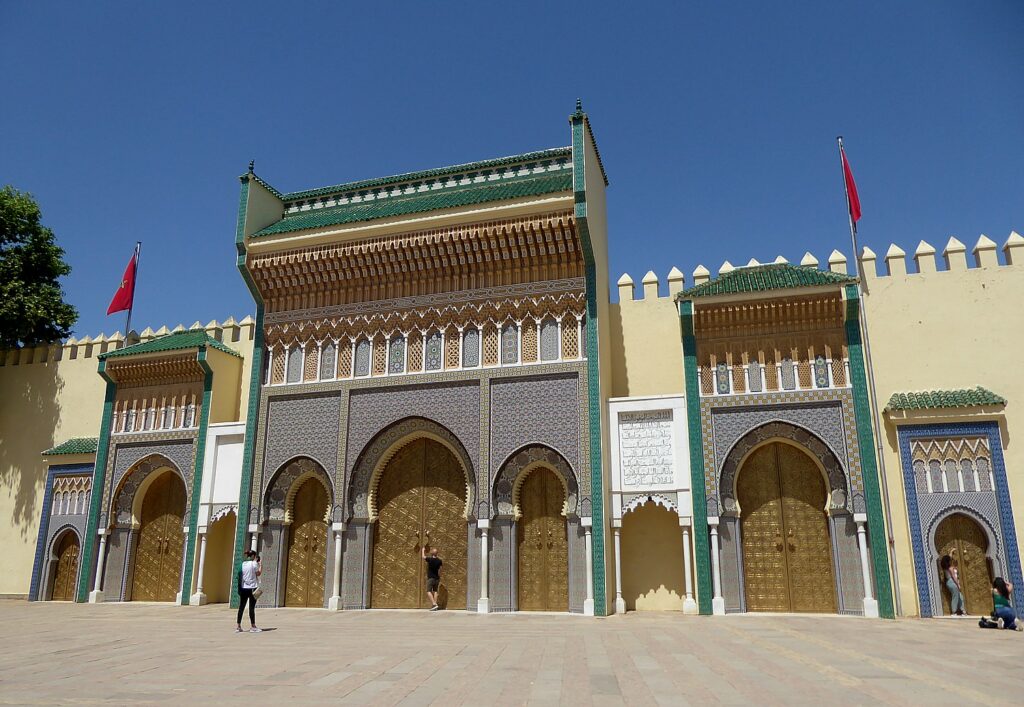
Our guide takes us first to Fez el-Jdid (the “new part of the city”, which is still a few hundred years old) to visit the Jewish Quarter, the Mellah..
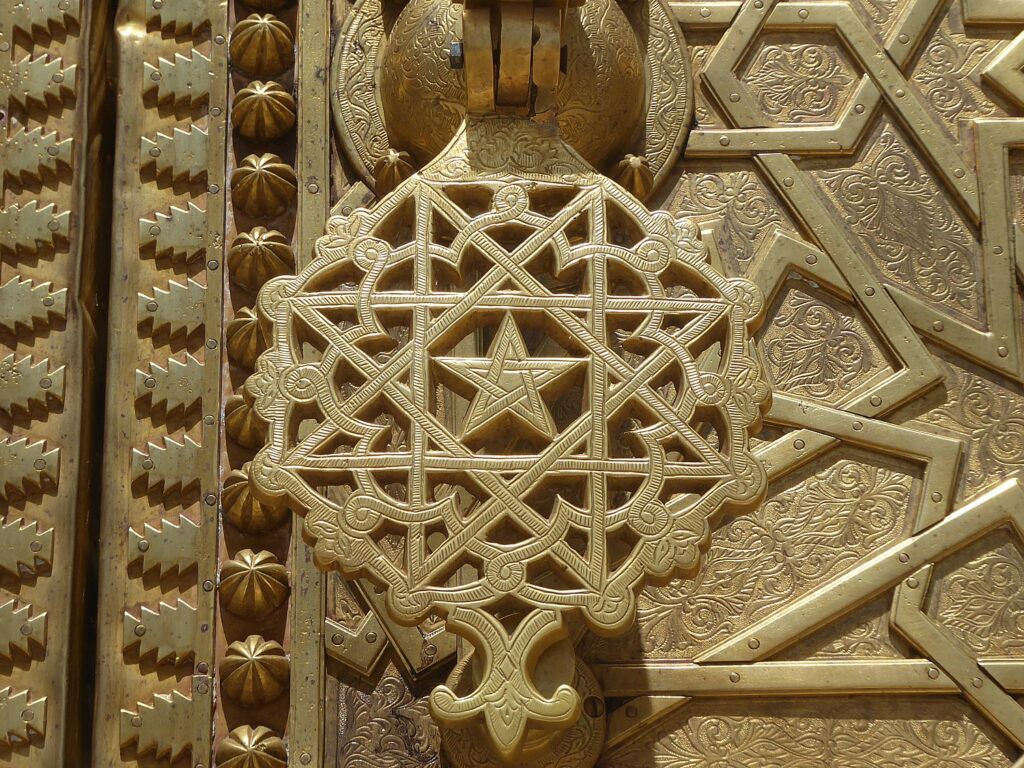
The Mellah of Fez dates back to 1438, the oldest Jewish Quarter in Morocco, though very few Jewish people live here today, most having moved to Casablanca, France or Israel; there are some 80 Jews left in Fez, but live in the new city, Ville Nouvelle.
Hamid tells us that this community continued even into World War II, when the Sultan gave Jews citizenship and protected them from the Nazis. Indeed, Morocco’s Jewish population peaked in the 1940s but since the 1950s and 1960s, following the establishment of Israel, shrank to fewer than 5,000 today.
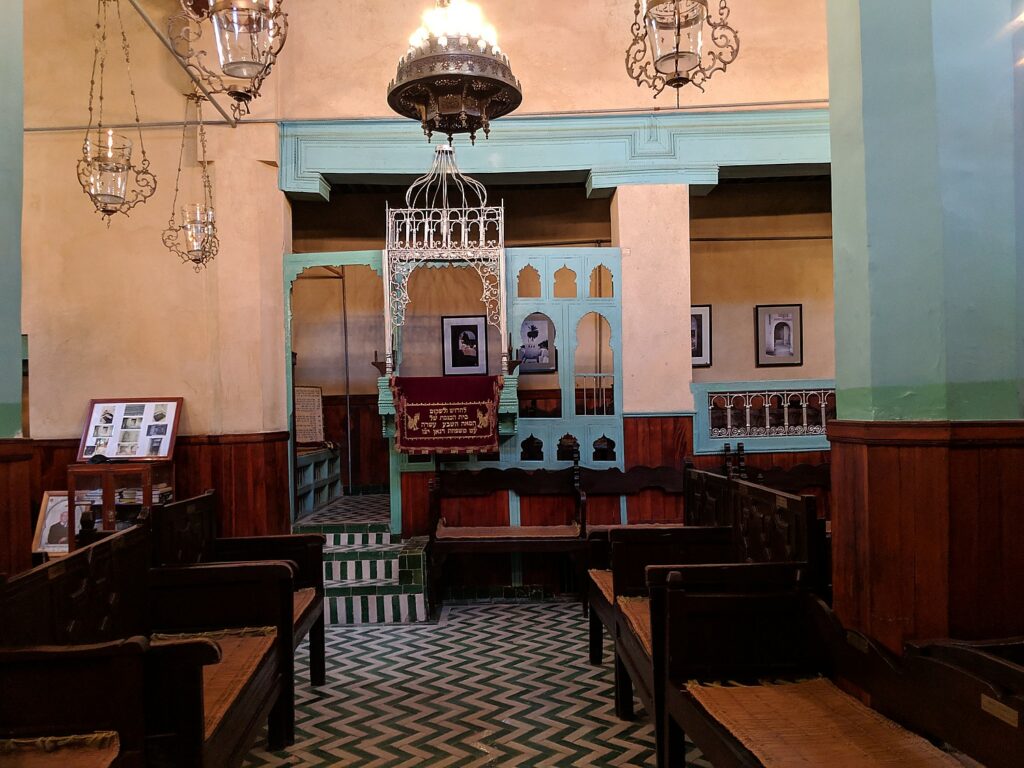
He leads us through winding narrow alleyways to the Ibn Danan synagogue. The synagogue was restored in 1998-99 with the help of UNESCO, American Jews and American Express). From the top floor, you can see the Jewish cemetery.
Nearby is al Fassiyine Synagogue, which a plaque notes, “belongs to the Jews (Beldiyine) Toshabirg, native Jews who lived in Fez before the arrival of the Megorashimns, the expelled Jews from Spain in 1492. The building, covering 170 sq meters was built in the 17th century. It includes a small entrance hall which leads to a prayer hall housing some furnished rooms on the mezzanine level. It has been used successively as a workshop for carpets and then a gym. Despite these different uses and the degradation of its state, it still keeps its original aspect.”
The synagogue was restored in 2010-2011 through the efforts of Simon Levy, former general secretary of the Judeo-Moroccan Heritage Foundation, the Jewish community of Fez, Jacques Toledano Foundation and the Foreign Affairs Ministry of Germany.
The reopening on February 13, 2013, was presided over by Morocco’s Islamist Prime Minister Abdelilah Benkirane inaugurated the reopening of the historic synagogue in which he conveyed the wish of Morocco’s King Muhammad VI that all the country’s synagogues be refurbished and serve as centers for cultural dialogue.
Hamid tells me that an adviser to the King and the ex-minister of Tourism were both Jewish.
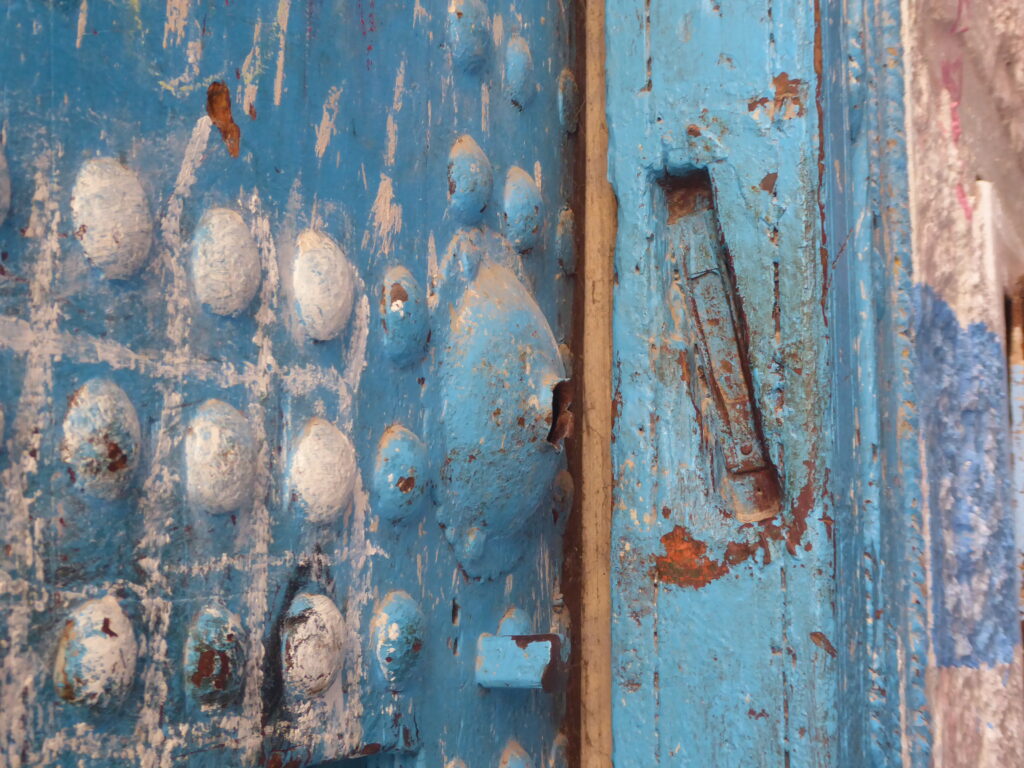
The tourism minister had a lot to do with putting Morocco on the map as an international tourist destination. The king, who studied at Harvard, in 2000 set a goal of 10 million tourists. “Morocco has no oil or gold. It had no highway or airport and didn’t exist except for hashish,” Hamid says. “The king opened Morocco to foreign companies, giving them five years duty-free. They were drawn by a peaceful country, a gateway to Africa. Foreign investors rebuilt the road to Marrakesh, turning it into an international city for the wealthy, like Europe.” Fez also seems to be benefiting – there is lots of restoration and new construction, at Riad el Yacout where we are staying.
As we weave through the alleyways, he shows us the indentation on the doorposts of houses where a mezuzah would have been placed, now the home of Muslims (what Jews remain in Fez live in the new city, Ville Nouvelle).
Zellige, Traditional Tile Making
Since we have a driver, we also visit a traditional tile factory, set on a hilltop overlooking the Medina.
Fez was the Moroccan birthplace of the beautiful tile work known as zellige. Introduced to the area by Moors fleeing Andalusia, tiles were initially chiseled into small pieces to create mosaic-like geometric patterns. The decorative and highly skilled tile work had become especially popular by the 14th century.
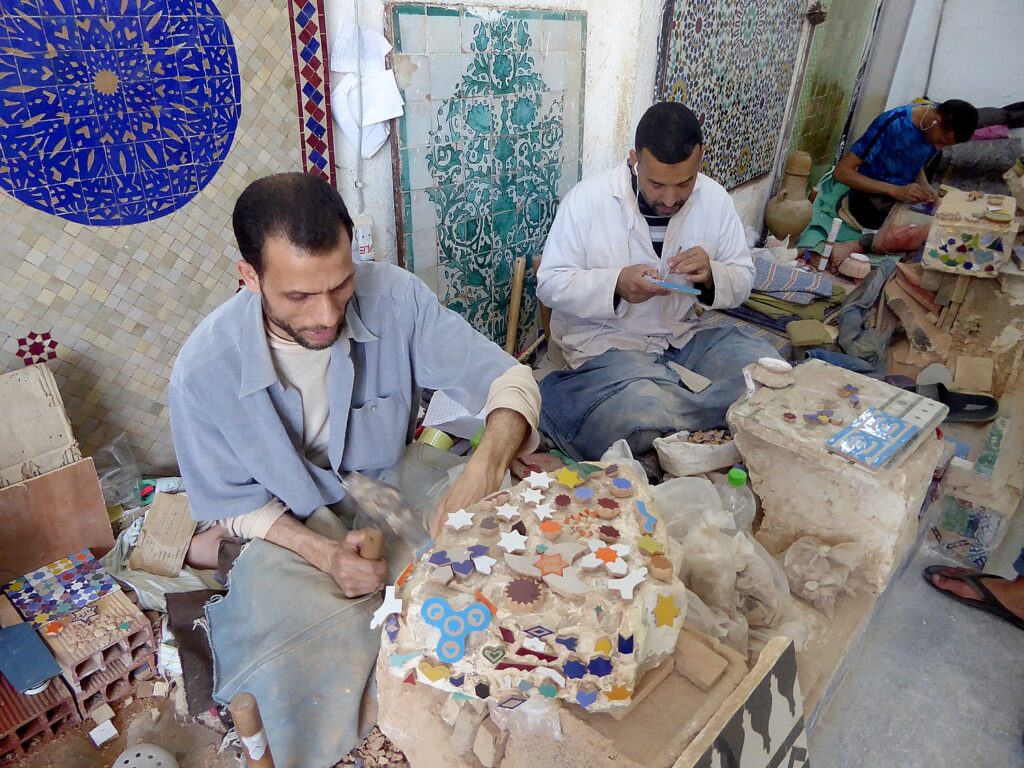
We go through various workshops and watch the various artisans as they chisel the pieces and set them into their patterns that we see in the stunning buildings of the Medina and the riad where we are staying. The colors come from natural material – mint for green, indigo for blue, saffron for yellow.
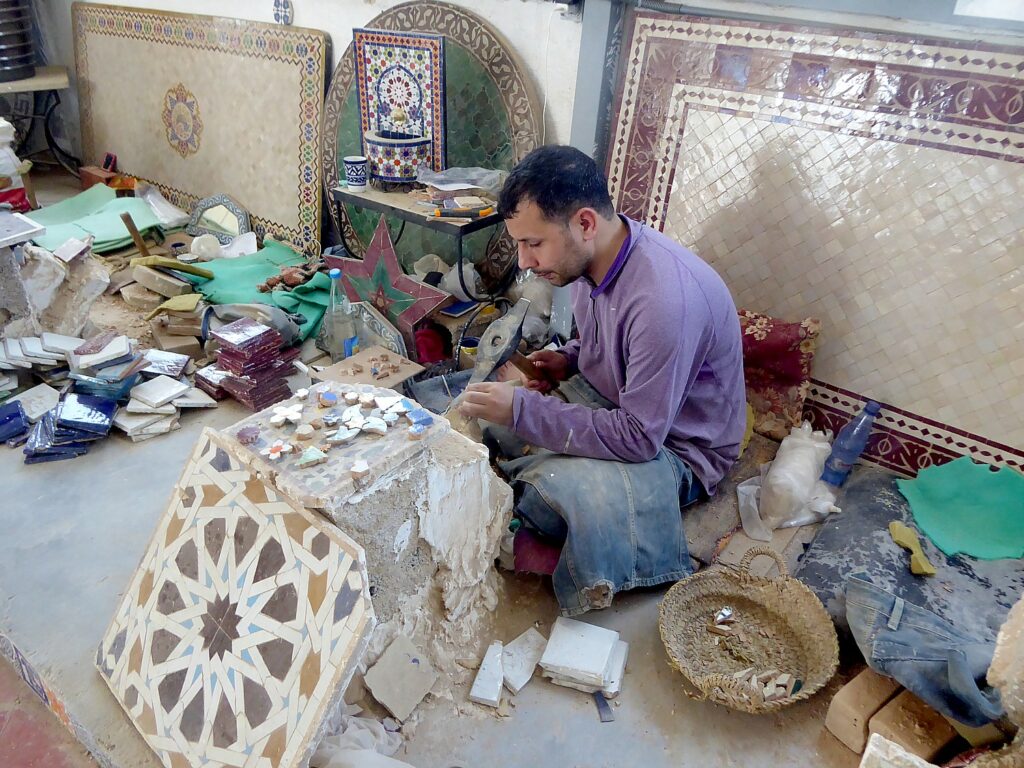
The tiles are different, Hamid explains. “Every other city uses terracotta; Fez has volcanic clay). They use olive pits as well as old furniture to fire up the kilns that heat the tiles.

Fez is Morocco’s third largest city, with a population of 1,275,000 – half of them in the Medina. It was under the French from 1912-1956. It was Morocco’s capital for 300 years before the French moved the capital to Rabat, on the ocean. The most remarkable part of the scene from the hilltop is how every roof of this ancient place has a satellite dish – Hamid says they were given for free by Al Jazeera. “Even a Bedouin tent in the desert will have a satellite dish.”
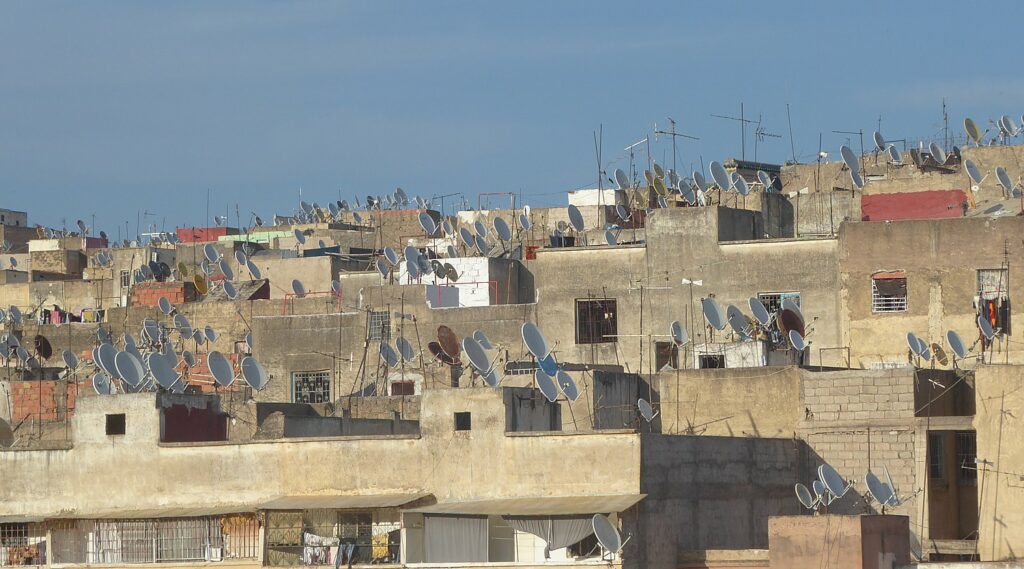
Fez el-Bali, the Medina
The driver drops us at one of the many gates into Fez el-Bali, the Medina (which means walled city) and we follow a route that takes us through the Medina. It is described as the world’s largest car-free urban space – 11,000 alleyways and no addresses – and is a UNESCO World Heritage Site (since 1983). The Medina is the oldest walled city, dating from 900 AD, and the largest in the Arab world. We find ourselves walking through 1,200 years and losing all sense of time or place – except when jarred back to the 21st century by the motorcycles coming through. It is one of the holiest places for Islam (Jerusalem and Mecca being the other two). There are some 272 mosques.
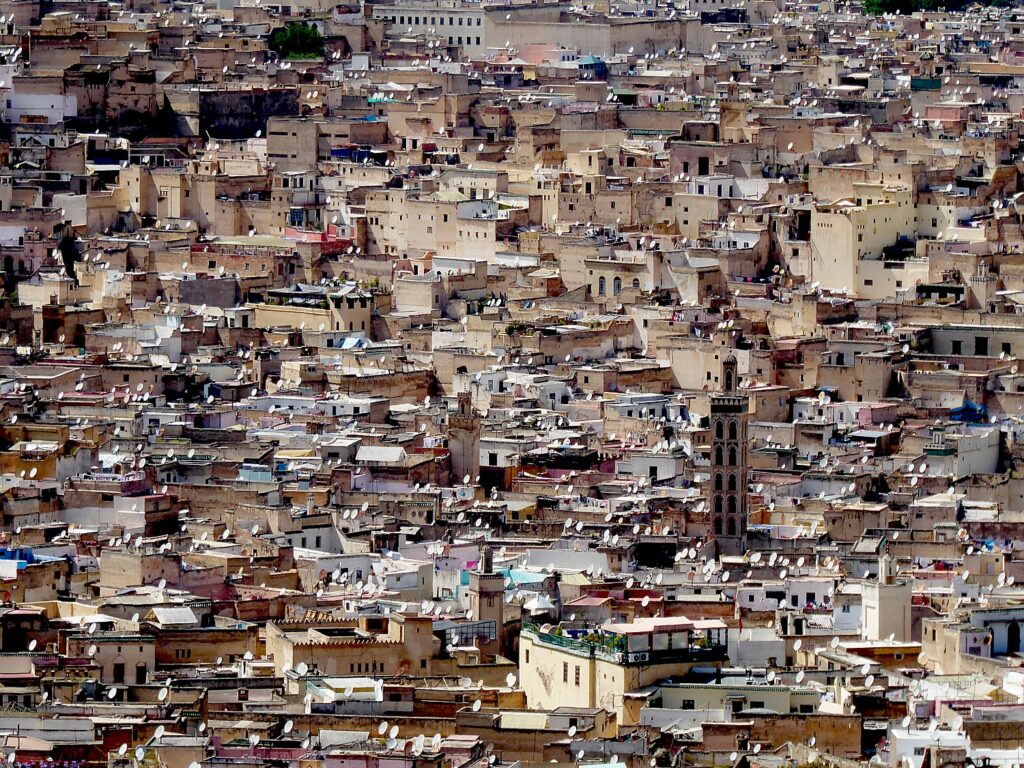
He points out how the homes are simple on the outside, with heavy doors (to keep out pirates); they are two-stories high, but very, very tall. The buildings are designed so if pirates came, they could pour hot water down. Hamid warns that an outsider can only go into the Medina during the day. “It’s not safe in the evening, not even for us.” Hamid says he was born in the Medina and lived here for 35 years, but moved to the New City to send his children to school. “Here, they first teach crafts; if they have more than 10 or 11 kids, they may send them to school.”
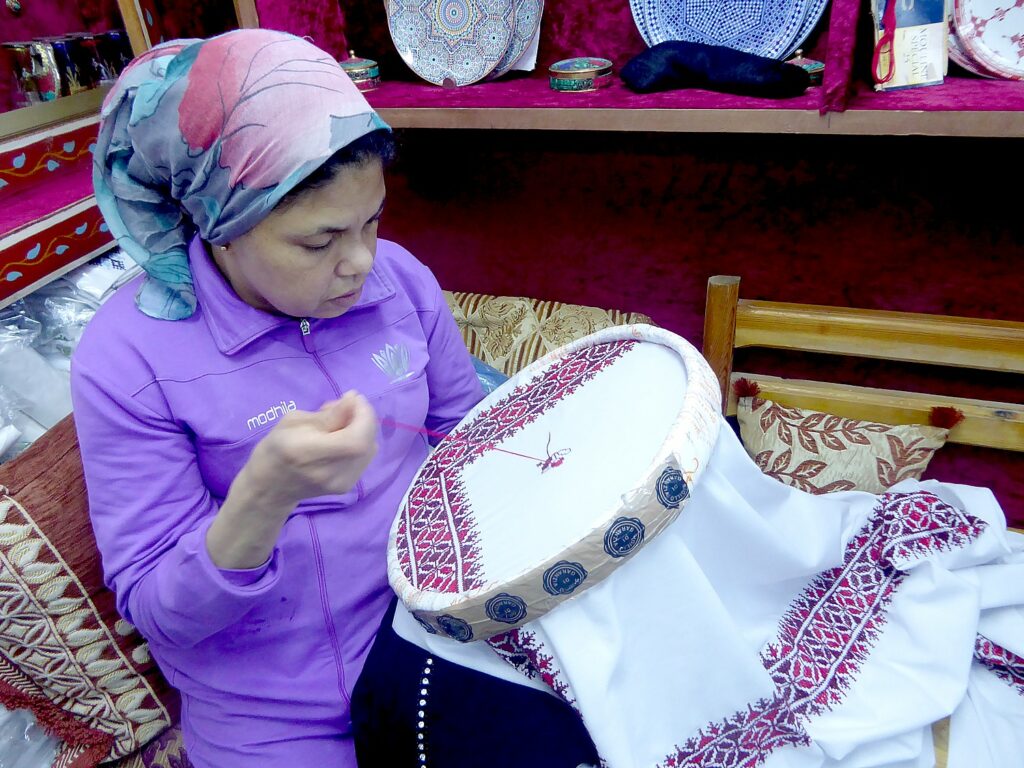
He tries to explain that women – the mother of the house – is the family’s bank; that the artifacts like carpets and ceramics are its financial security, “like diamonds and gold. If the family needs something, they sell something.”; a mule was like a Mercedes.”A carpet to sell is like an ATM; a wife who is an artist is like insurance.” He explains that the people of the Medina have no health care, no insurance and pay no taxes. “It’s like the 8th century.. If a wife doesn’t save money, the family is in trouble. Once a year, they will show off it they have a real wife at the Ramadan holiday. The mother chooses a wife for her son; a daughter goes off to live with the husband’s family. “A mother who has 8 sons is like a Queen, insurance guaranteed. If a family has no sons, they will adopt a nephew as a son. That system from the 9th century is still in practice in the Medina.”
Garbage is still collected by donkey; the sewage system is Roman. The French introduced a water system and electricity – up until then, they used candles and oil lamps. Homes still don’t have refrigerator.

An important stop is al Qaraquiyine (Karaouine) mosque, university and library, founded in 859 by Fatima al-Fihri, a woman who had fled her homeland of Tunesia. The madrasa became one of the leading spiritual and educational centers of the Muslim world. It was incorporated into Morocco’s modern state university system in 1963. It is considered the oldest existing, continually operating institution of higher education in the world. Hamid tells us that the university spans 5 hectares.
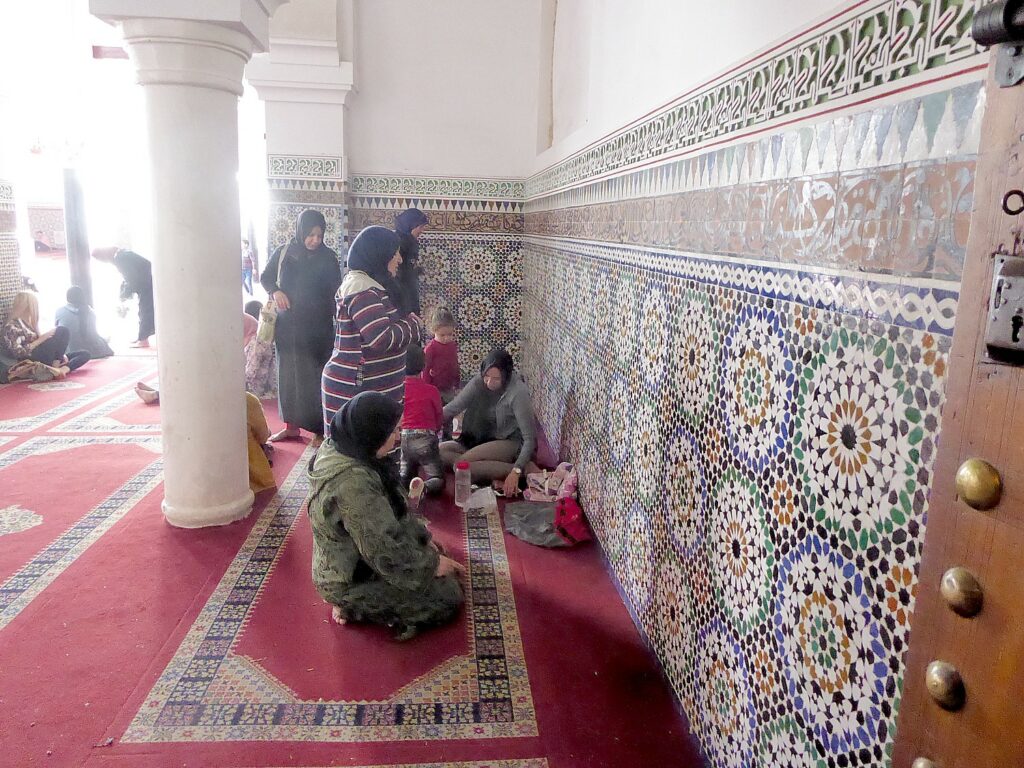
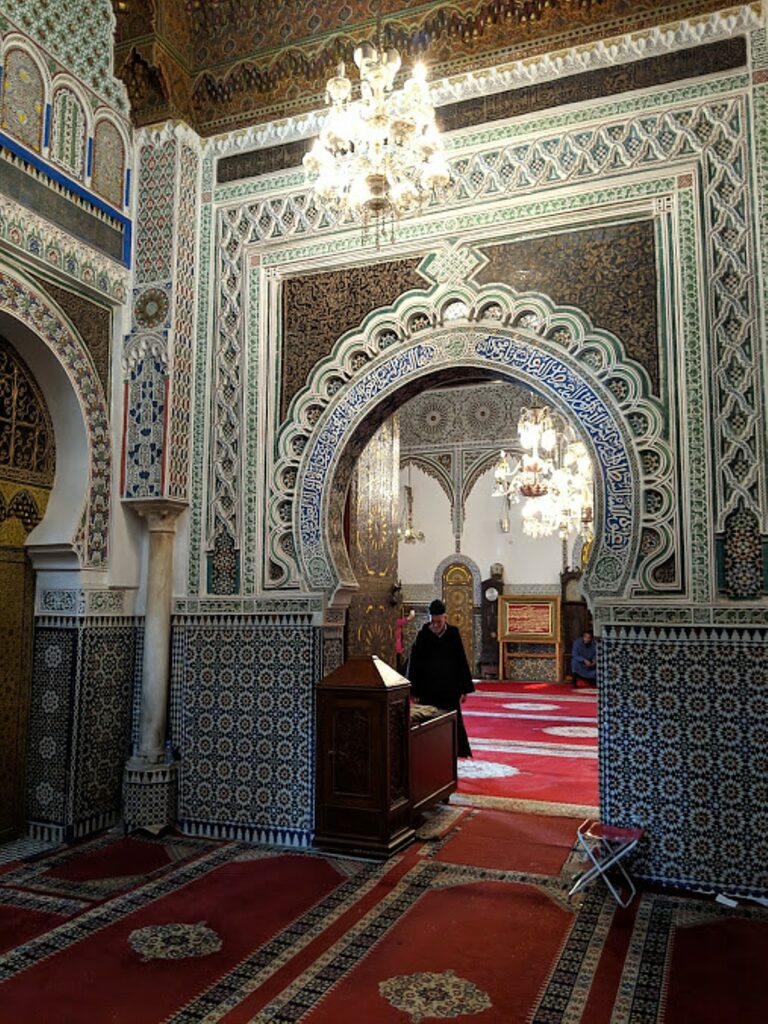
I later learn that in addition to being Muslim, prospective students of the Qarawiyyin are required to have memorized the Qur’an, medieval Islamic texts and Maliki law, and have a very good command of Classical Arabic. And while most assume the university is open only to men, women have been admitted into the university since the 1940s.
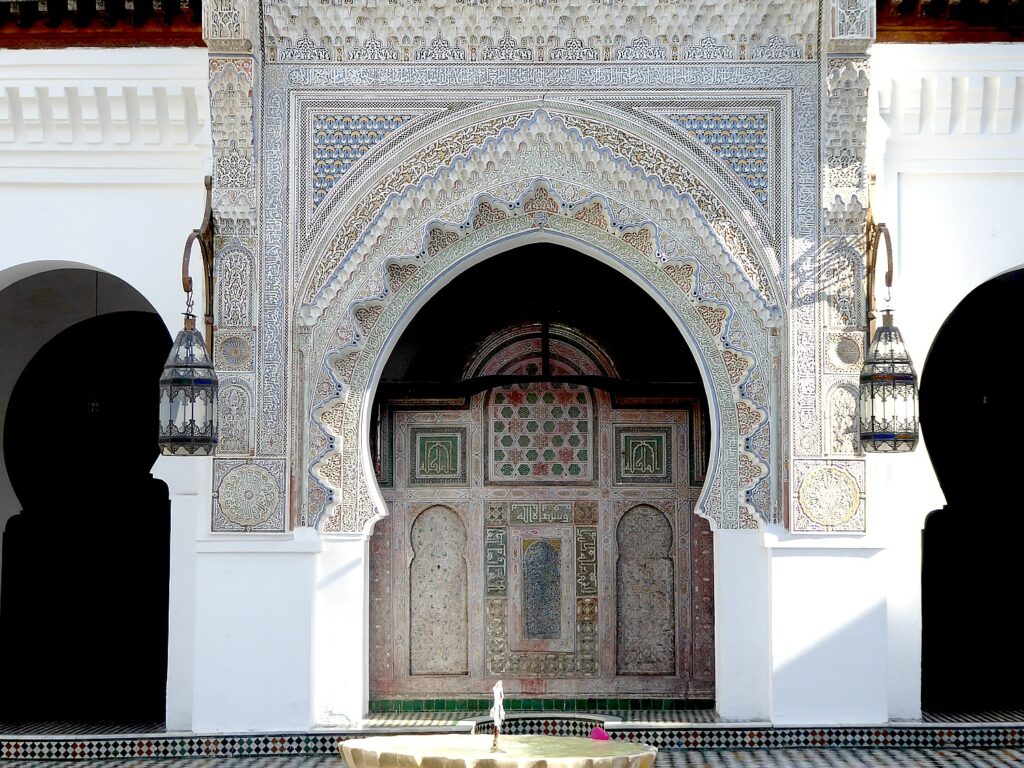
The libraries contain important documents dating from c. 780 A.D. including the Al-Muwatta of Malik written on gazelle parchment. The libraries may soon be open to the public.
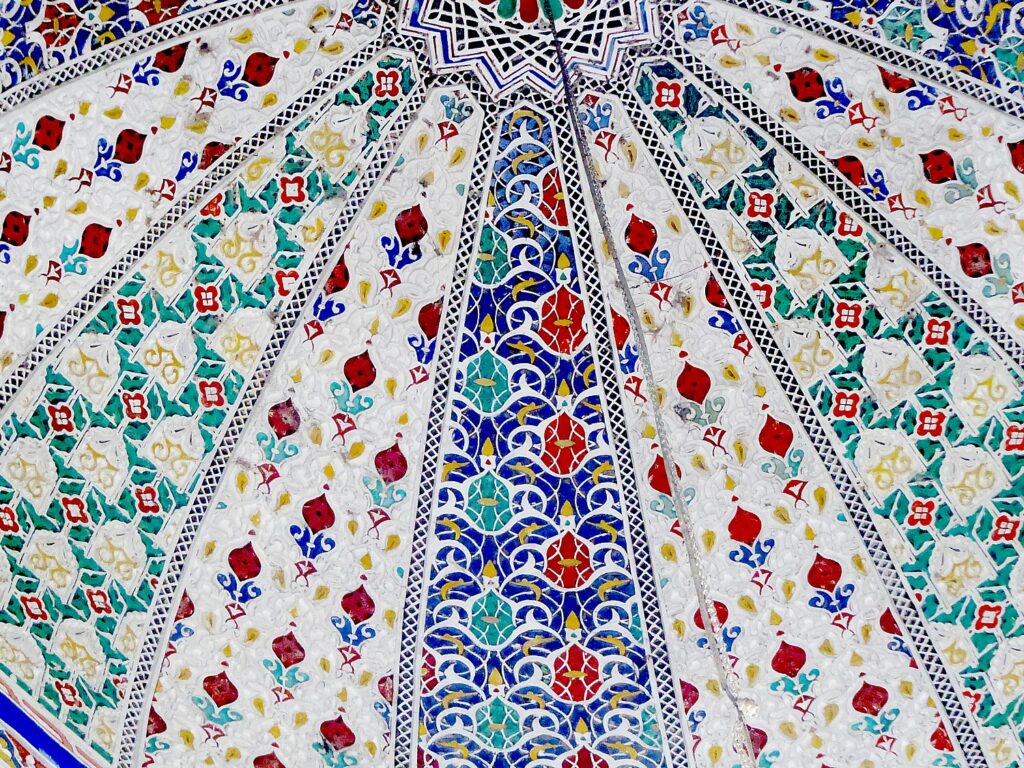
Fez was founded in 789 A.D. by Moulay Idriss II, the son of the founder of modern Morocco, according to Journey Beyond Travel. It wasn’t until 817-18 A.D., when around 800 refugee families from Cordoba in Spain settled in Fez, followed a few years later by over 2,000 families from Tunisia, that Fez really began to grow. Apparently, settlements fought each other for over 300 years, until the arrival of the Almoravid empire in 1070 A.D. installed stability peace.
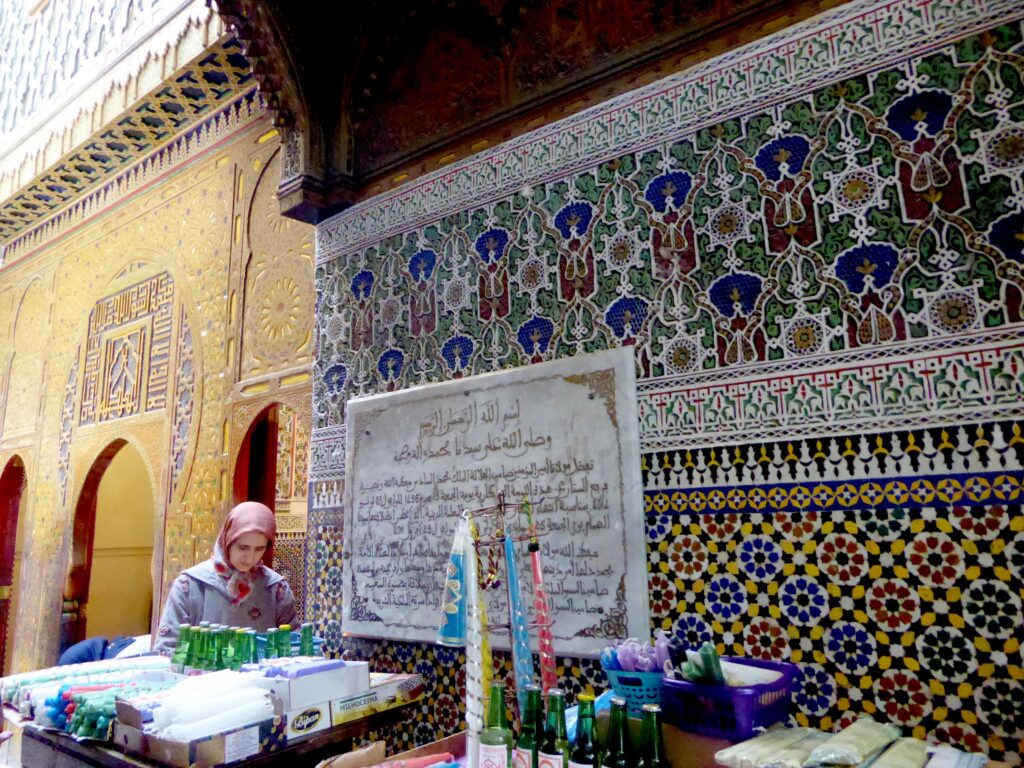

The city took form under Almoravid rule when the walls which still form the outline of today’s Fez El-Bali were erected. By 1170 A.D., Fez was the largest city in the world with a population of 200,000. Fez was an important trading hub, serving Africa and Europe, the gold route from Timbuktu, and because of its tanneries with a reputation for making leather shields.

When the Merenids took control of Morocco in 1250 A.D., they made Fez their capital. This is when Fez el-Jdid, the “new” city where the Jewish Quarter is, was built with wider streets, gardens, and administrative centers. This is also when Fez became established as a cultural and intellectual hub and the “Fassi” style, a mix of Andalusian and Almohad traditions, began. One of the best examples of this architecture is the Medersa Bou Inania with its green-tiled minaret.
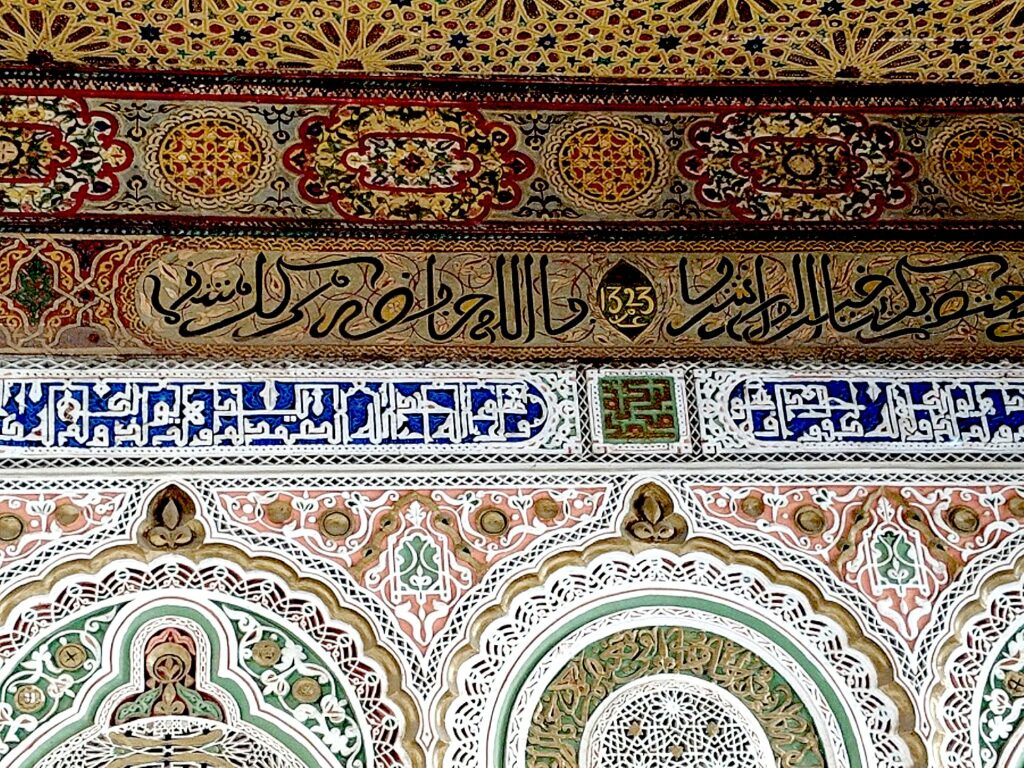
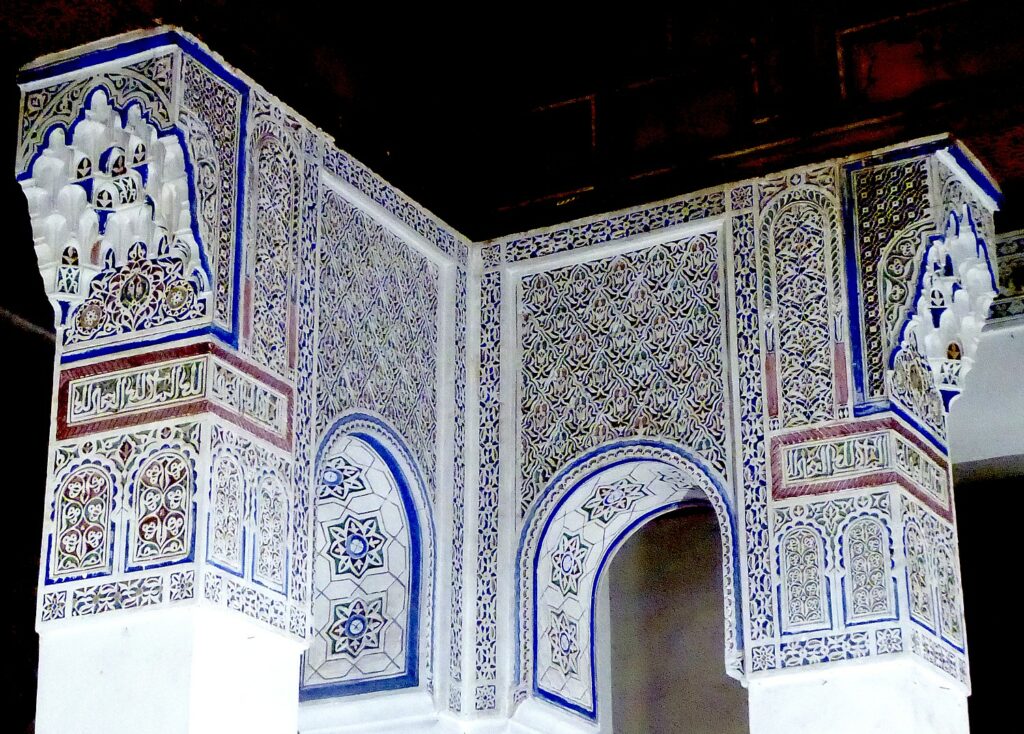
“Today, Fez is known as the ‘Athens of Africa’ and the “Mecca of the West” for its history and role as the spiritual and learning capital of Morocco.” (www.journeybeyondtravel.com/morocco/fez)
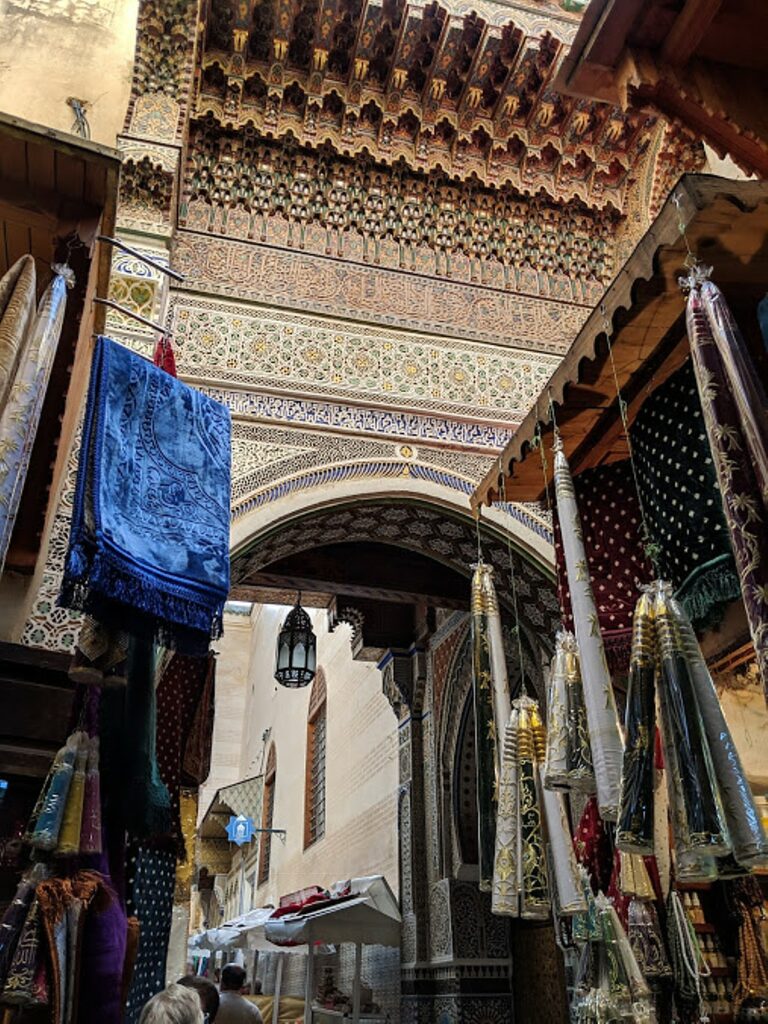
We see the beautiful tile work of the mausoleum of Zaouia Moulay Idris, built in the Alawi architectural style, beginning in 1717 while Moulay Ismail was alive and finished in 1824. It is an important pilgrimage site, and one of the many sites that are closed to non-Muslims.
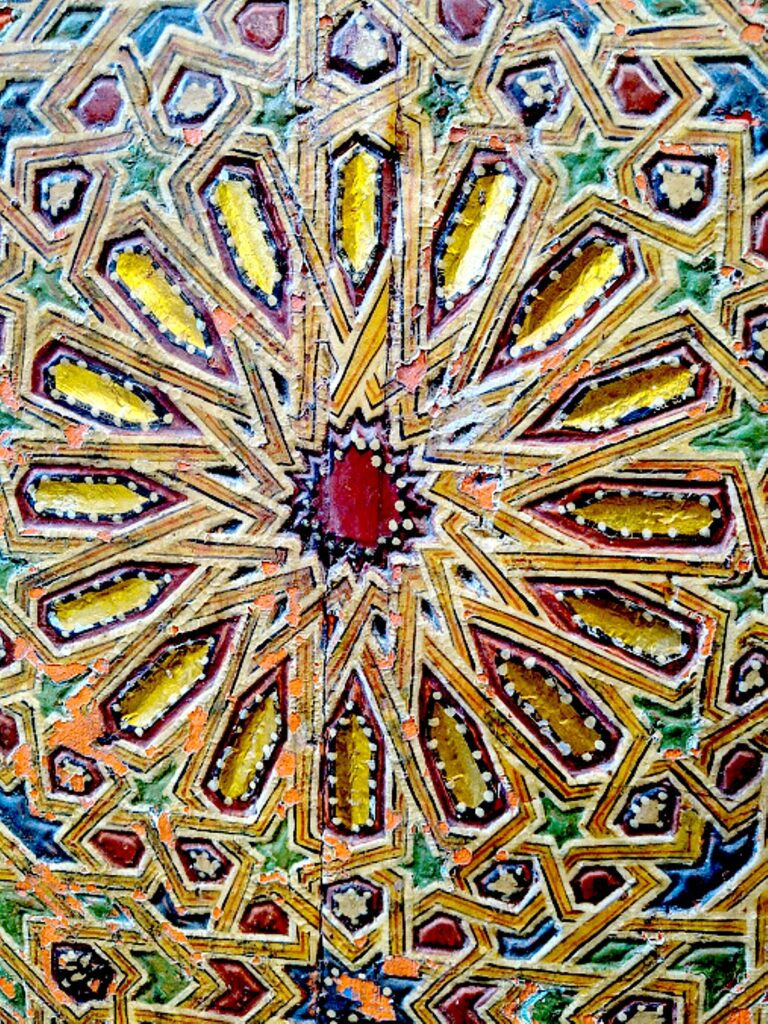
During the course of the afternoon, we visit various craftsmen and artisans including embroiderers, carpet makers and weavers.
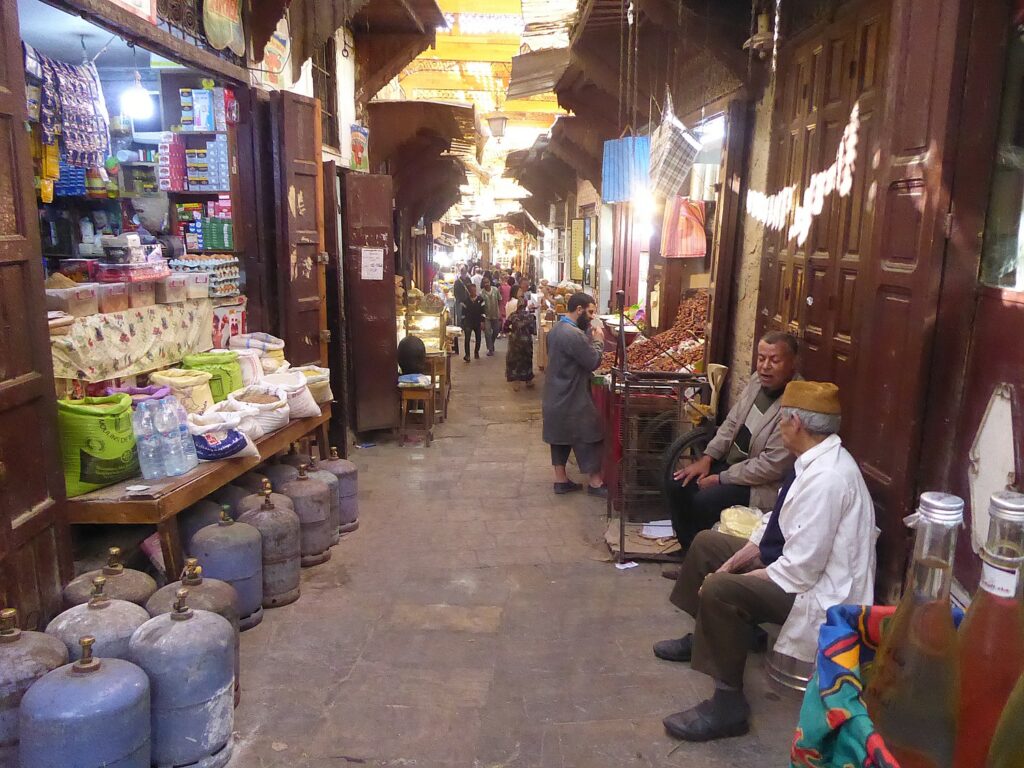


One of these is the Widows Coop, where women weave carpets and scarves. Hamid explains that women who are divorced or widowed have little opportunity to remarry, and in the past, had few opportunities to earn a living besides prostitution. The Widows Coop gives these women a means for self-sufficiency. “Ladies with golden fingers.”
The final stop is the Chouwara tannery which has absolutely exquisite leather items for sale, and a fantastic view from its roof down to the vats of dyes. We learn that they use lime, salt and pigeon droppings to make the ammonia to tan the leather; the skins soak for a week, then are put into a wheel and turned every day for two weeks, then bleached for a week, then washed for three hours, then put into a vat to dye.

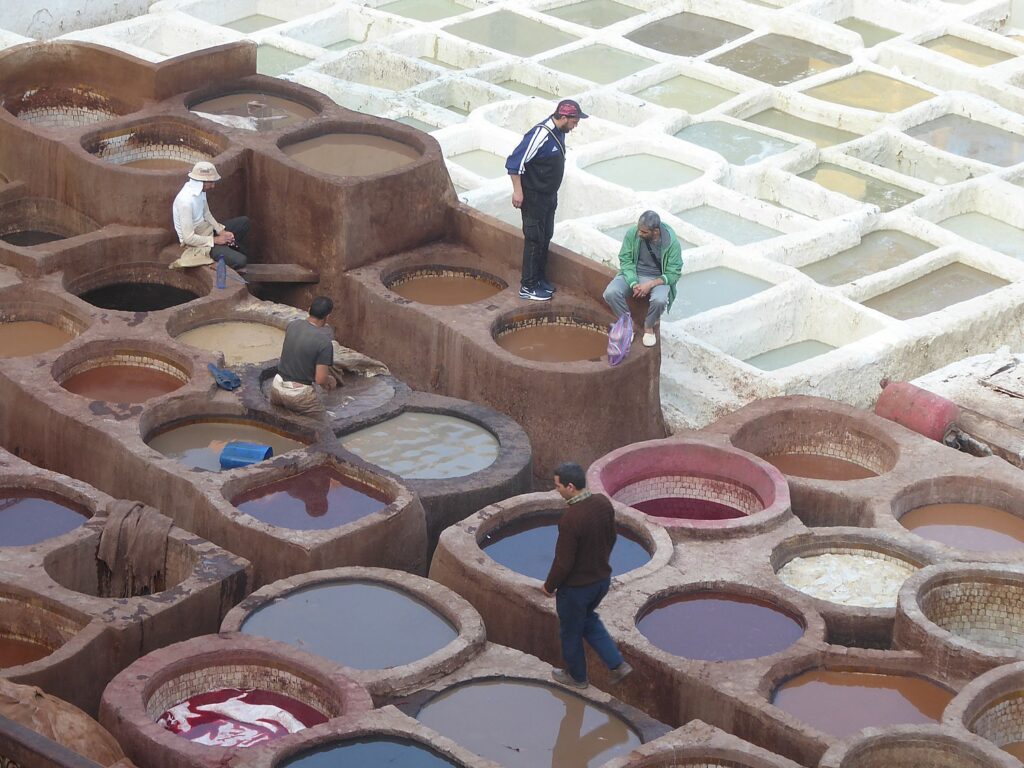
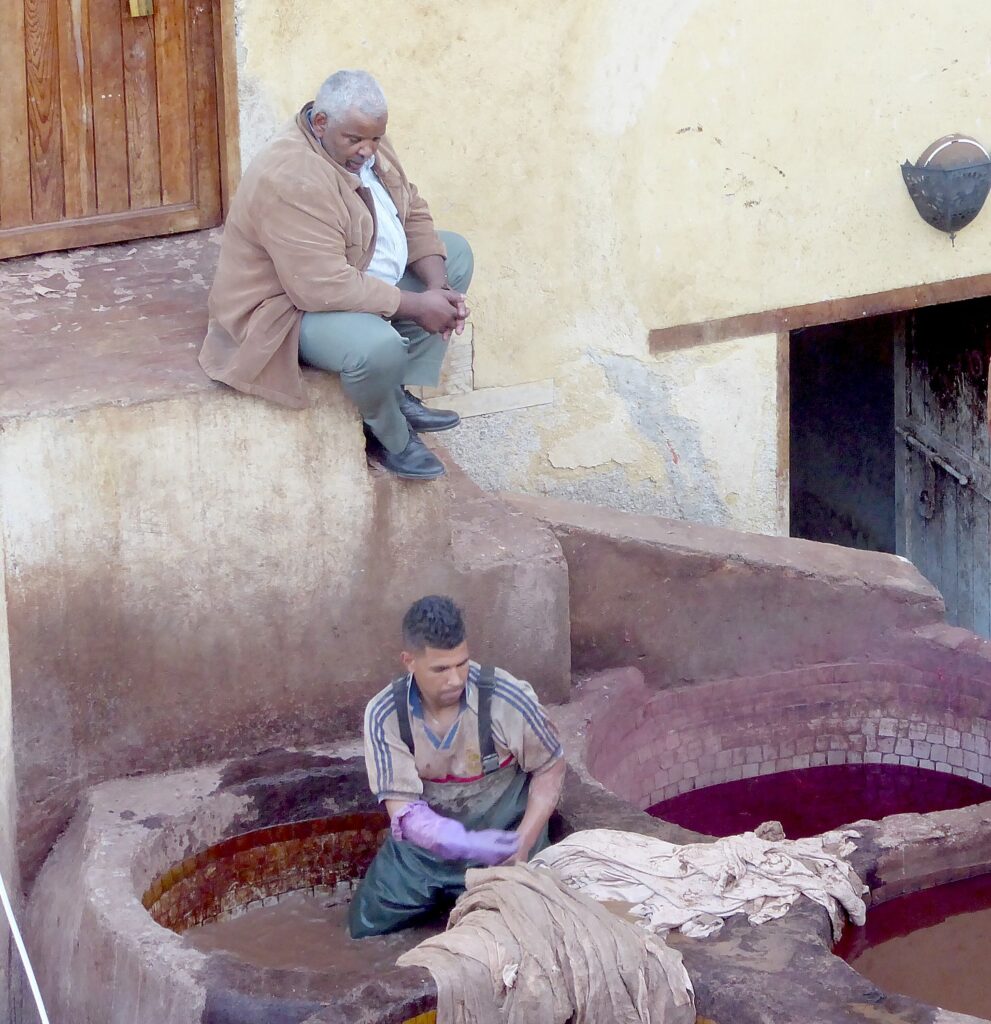
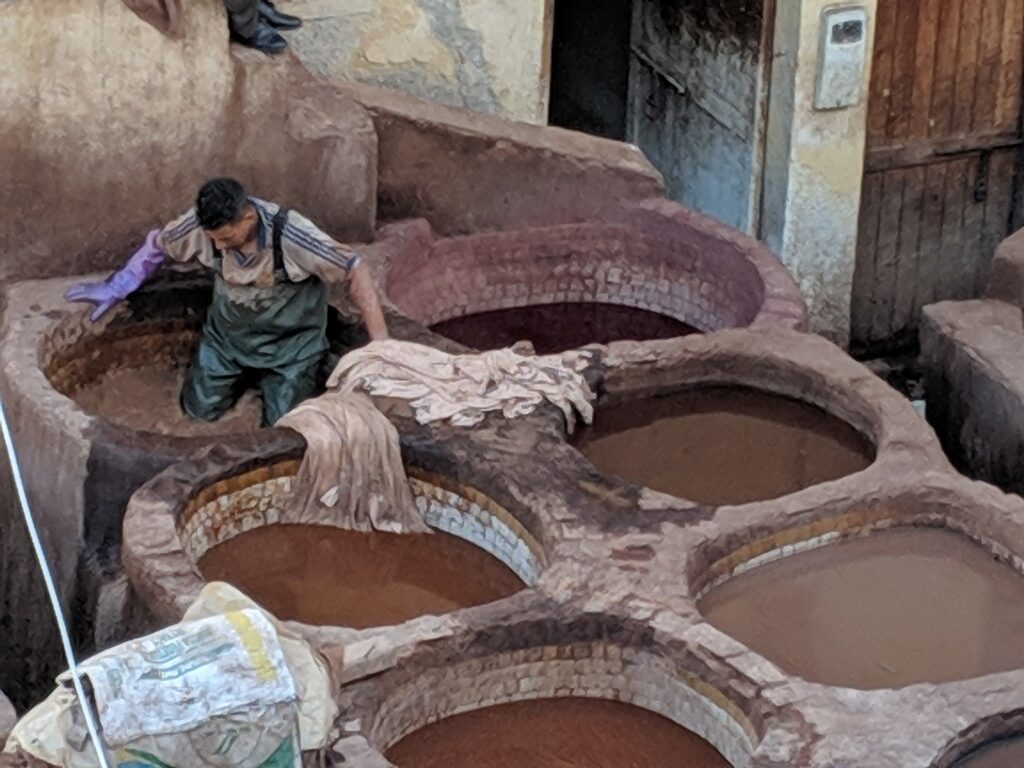
The shop is exquisite (even after getting this glimpse of how the sausage is made) – I have never felt such soft leather. Margo, who protested shopping, falls under the spell of a jacket, but it needs some tailoring. They take measurements and promise to deliver the jacket that evening. Sure enough, a completely custom jacket is delivered to the riad. It is stunning.
Leaving, we drive alongside the walls of the Medina and pass by the famous Bab Boujeloud known as the “Blue Gate”.


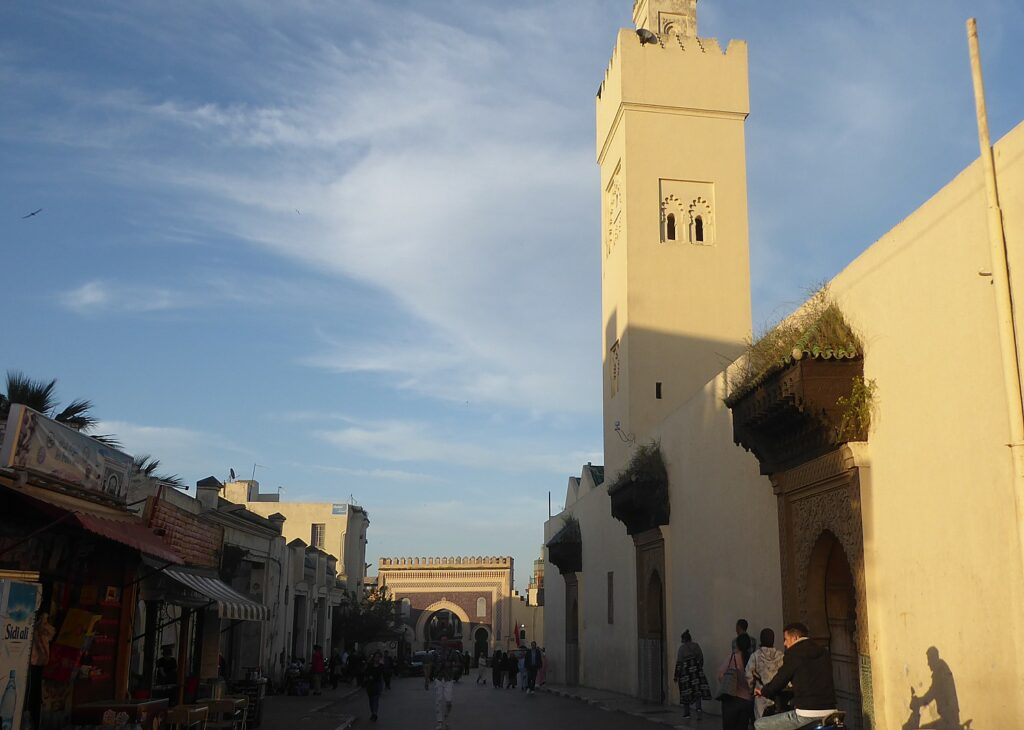
(As I reflect on this guided tour, I am disappointed because as can be expected, we spent most of our concentrated time at the tile factory, the weavers, the carpet makers and the tannery – all designed to have us spend money, but did not get to properly see the Blue Gate, which I “grab” as we are driving or Medersa Bou Inania, two of the Medina’s most important sites. I have trouble reconstructing what we saw.)
Back at Riad el Yacout, we meet up with the other two teams and discover that all of us have followed pretty much the same itinerary.
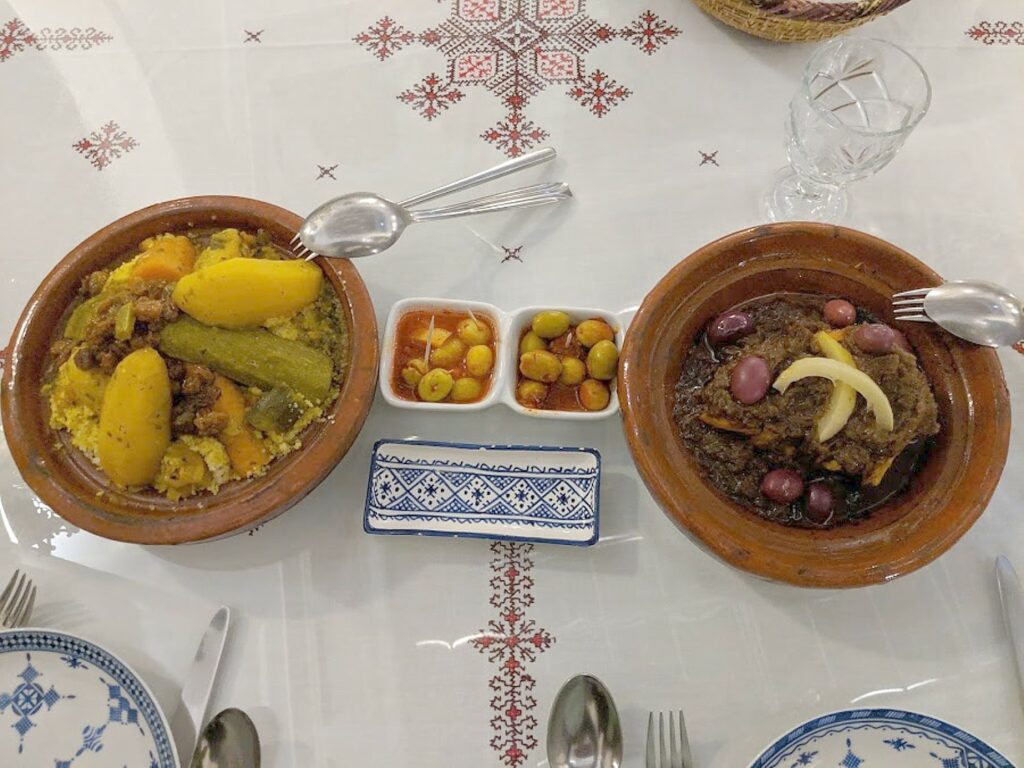
We have a fantastic dinner at the riad – chicken tagine and chicken couscous – the food and the atmosphere sheer perfection. (Rian el Yacout, 9 Derb Goebbas Batha, Fes Medina 30200, Morocco, riadelyacout@gmail.com, www.riadelyacoutFes.com).
We still have to get from Morocco to Gibraltar to Seville to Porto by Friday on this most challenging, Par 6 leg of the Global Scavenger Hunt, our “final exam.”
I have been unable to figure it out online. It turns out we need to take a ferry to the Spanish city of Algeciras, and then get a cab to the border of Gibraltar (my mistake was trying to input Tangier to Gibraltar). But there are two ferries and two different ports. Which one?
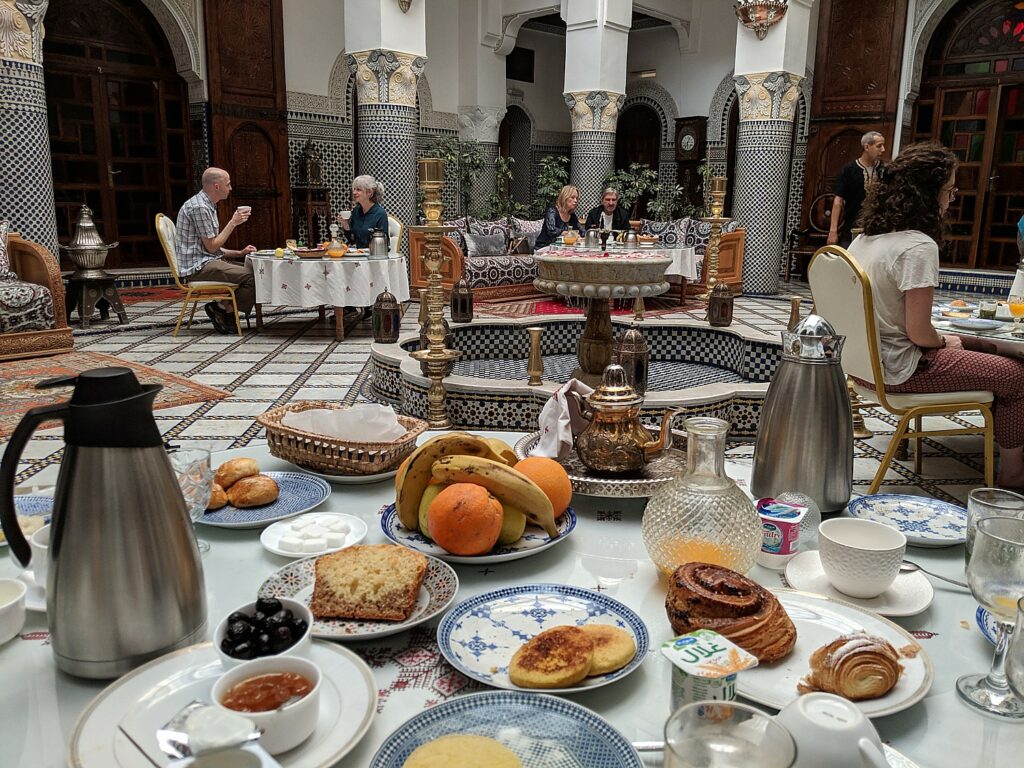
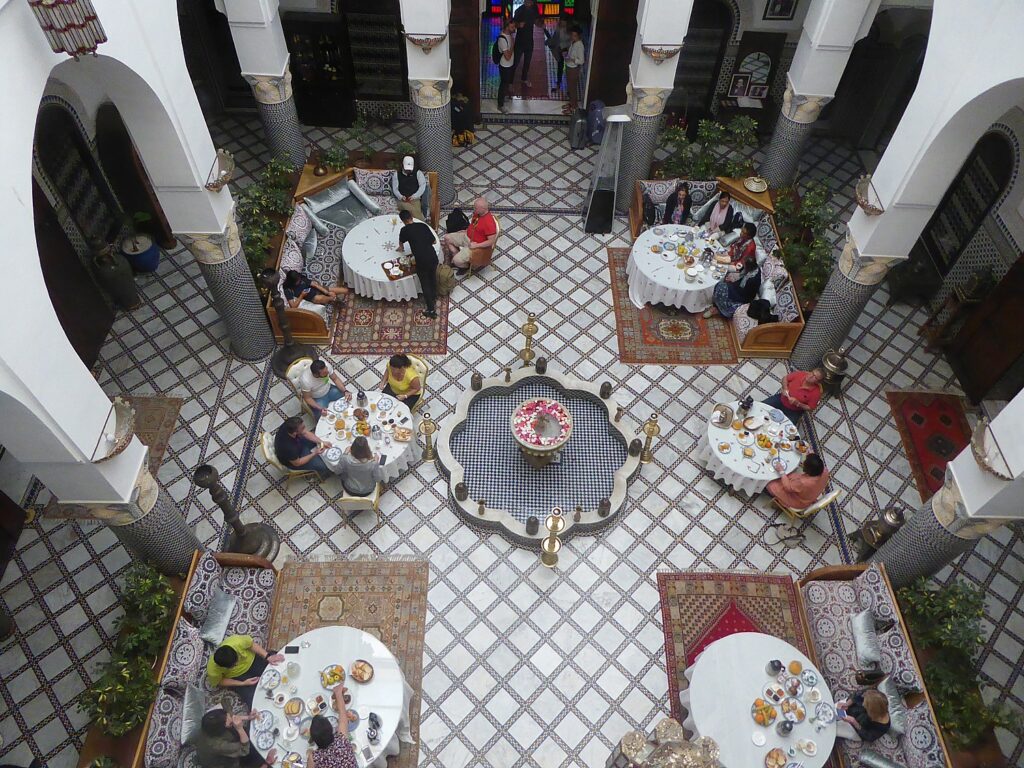
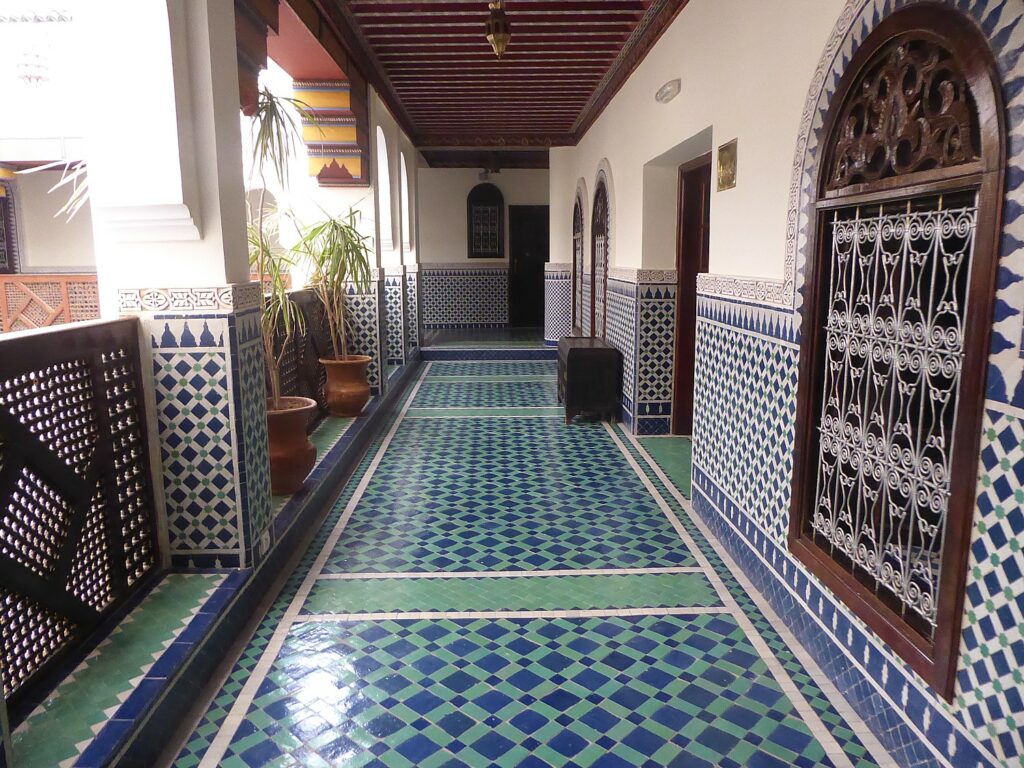
The other two Global Scavenger Hunt teams who are staying in the riad (they were the ones who found it) seem very sure of knowing which train to take and say they will figure out which ferry when we get to Tangier, so, after a fantastic breakfast set out early for us, at 8 am, served in the gorgeous courtyard, we pile into cabs for the $1.50 ride to the train station.
We purchase ticket for the 10 am (first class) train to Tangier Ville. The 4 ½ hour trip is very pleasant, rolling passed lovely landscape, farms, towns and villages, stopping perhaps six times to pick up passengers. A cart of refreshments comes by (tea costs something like 6 cents).
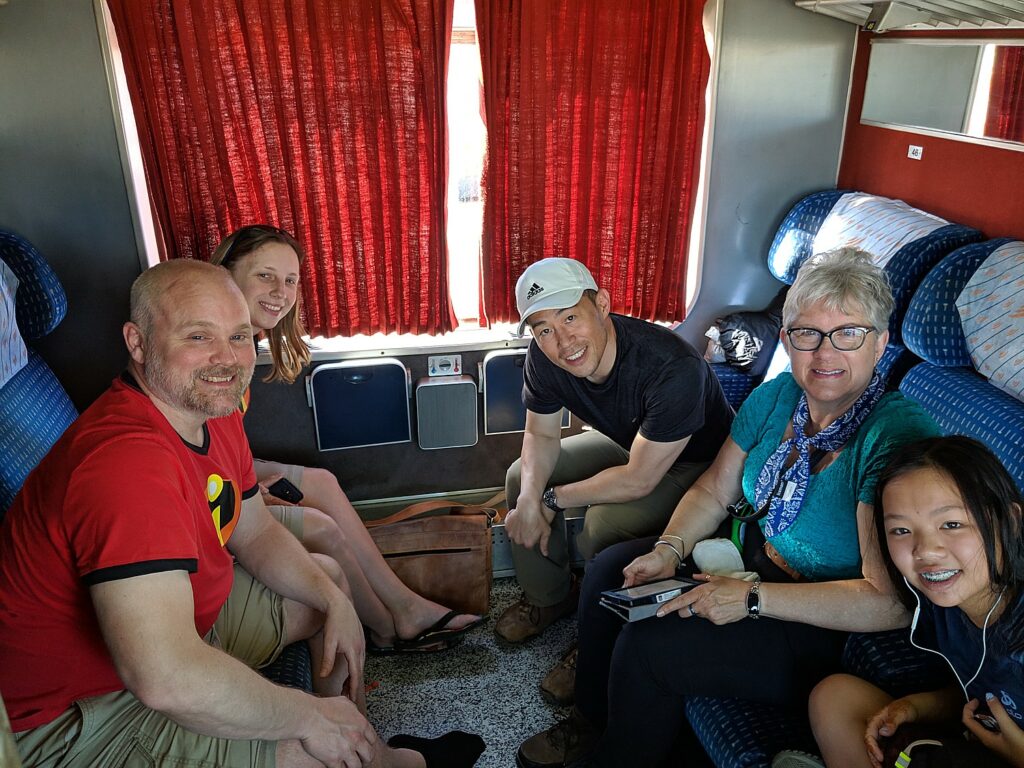
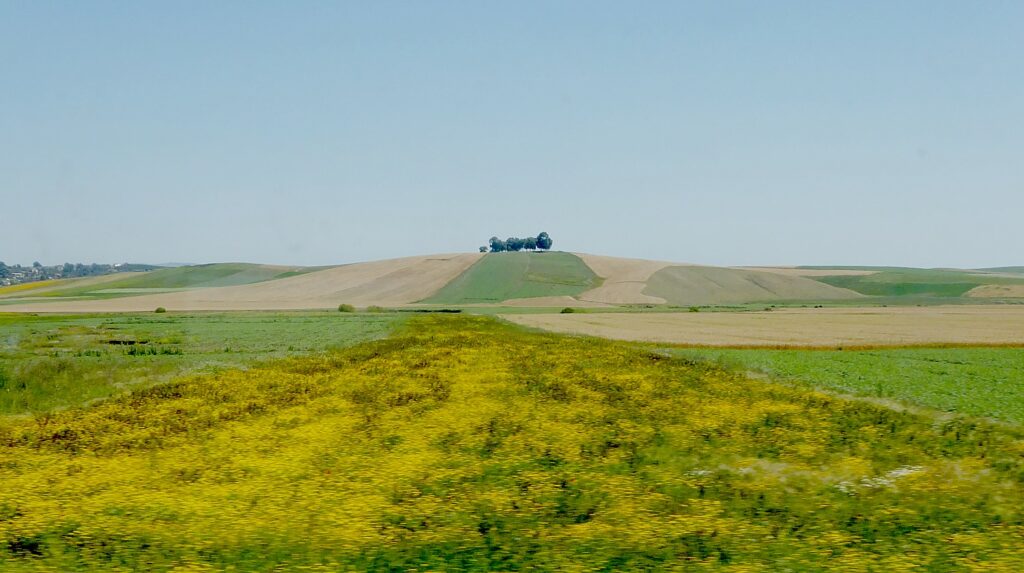
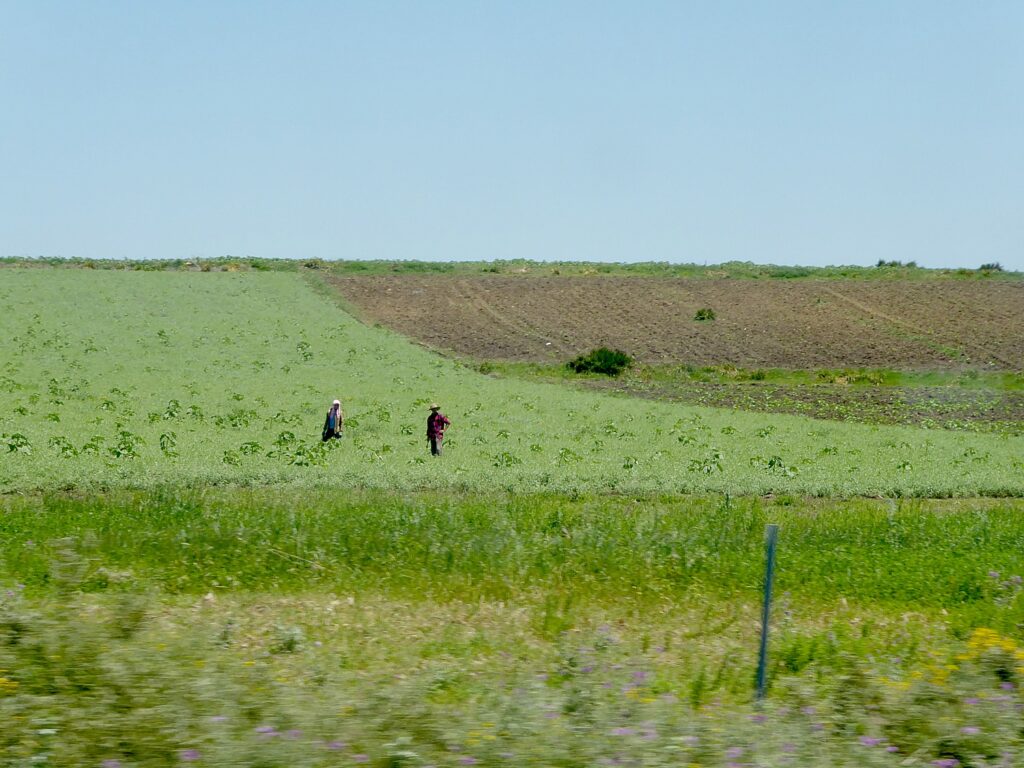

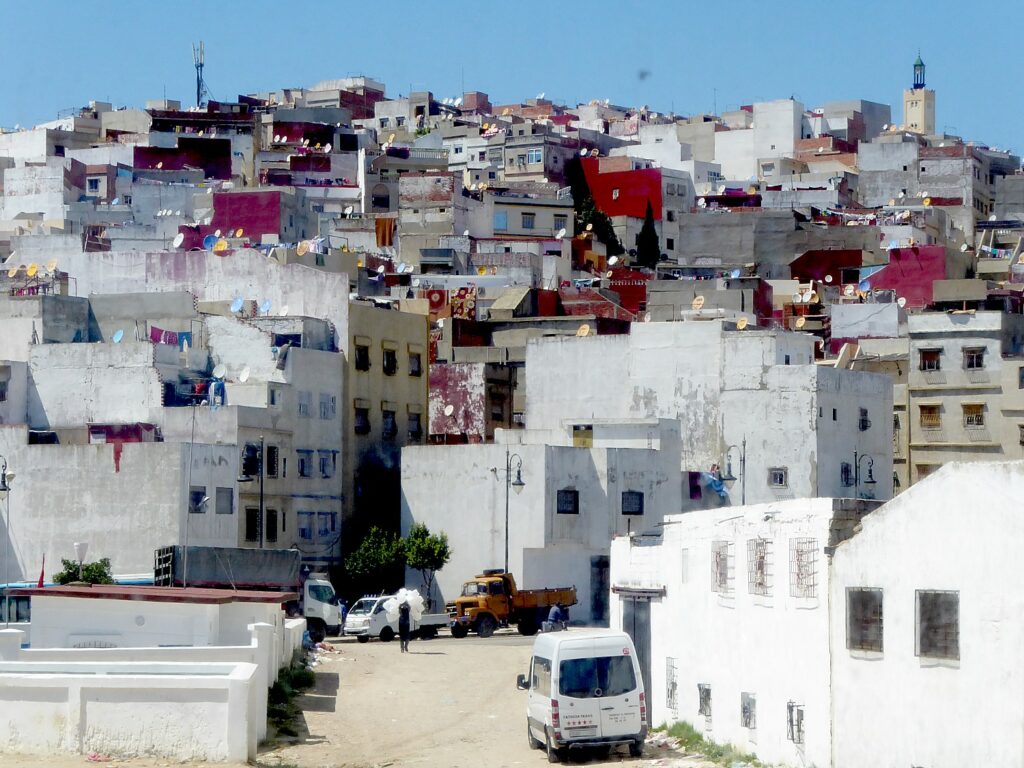
We are on our journey to Gilbraltar.
(Zoe and Rainey Littlepage, Lawyers Without Borders, the team leading the Global Scavenger Hunt, published a brilliant blog documenting how they fulfilled dozens of the scavenges: https://zoeandraineygreatescape.blogspot.com/2019/05/gsh-2019-from-minurets-in-morocco-to.html )
The Global Scavenger Hunt is an annual travel program that has been operated for the past 15 years by Bill and Pamela Chalmers, GreatEscape Adventures, 310-281-7809, GlobalScavengerHunt.com.
See also:
Unraveling Marrakesh’s Old City Maze Before Tackling the Global Scavenger Hunt 4-Country Challenge
4 Days in Morocco: Desert Adventure from Marrakesh to the Sahara
________
© 2019 Travel Features Syndicate, a division of Workstyles, Inc. All rights reserved. Visit goingplacesfarandnear.com, www.huffingtonpost.com/author/karen-rubin, and travelwritersmagazine.com/TravelFeaturesSyndicate/. Blogging at goingplacesnearandfar.wordpress.com and moralcompasstravel.info. Send comments or questions to FamTravLtr@aol.com. Tweet @TravelFeatures. ‘Like’ us at facebook.com/NewsPhotoFeatures
